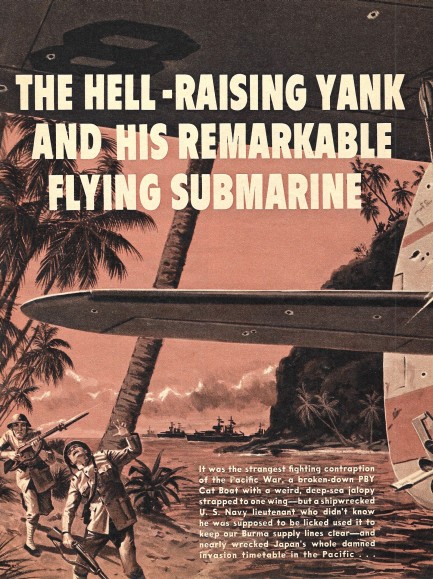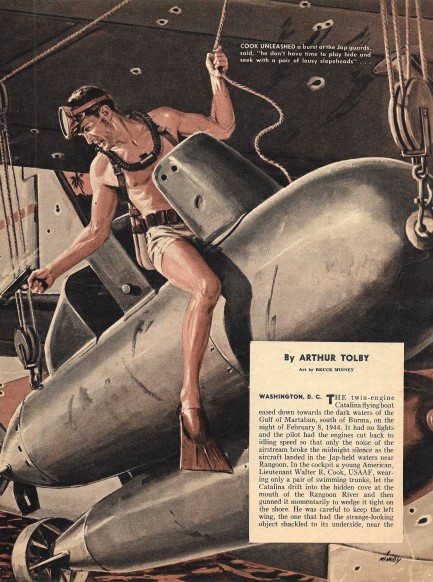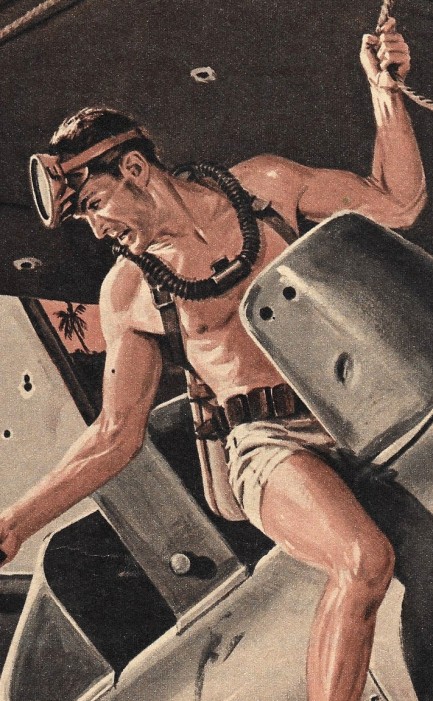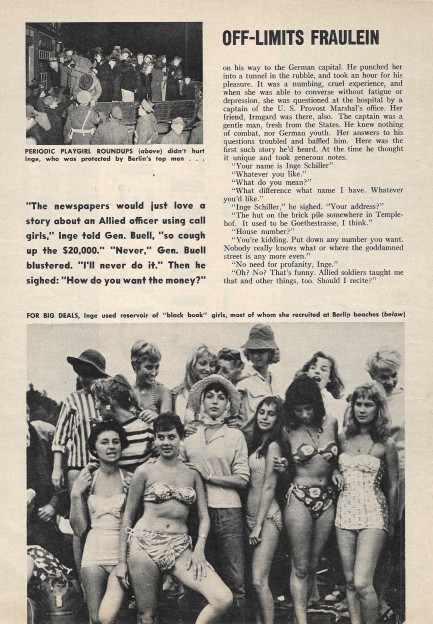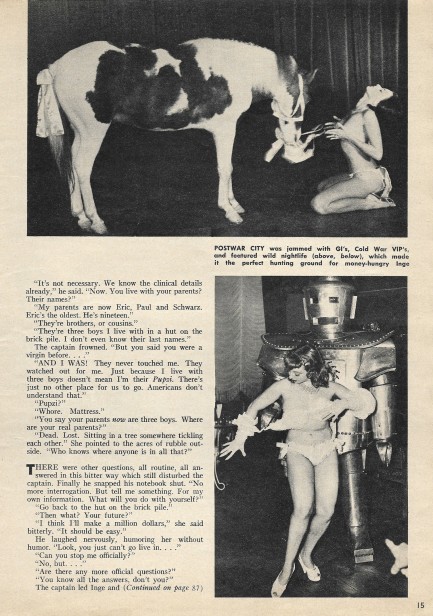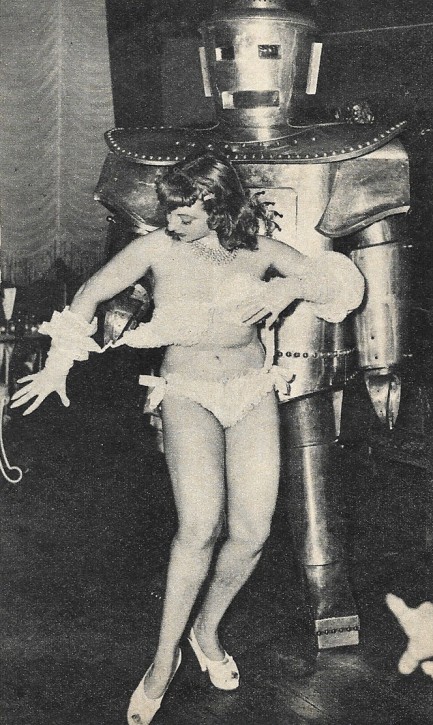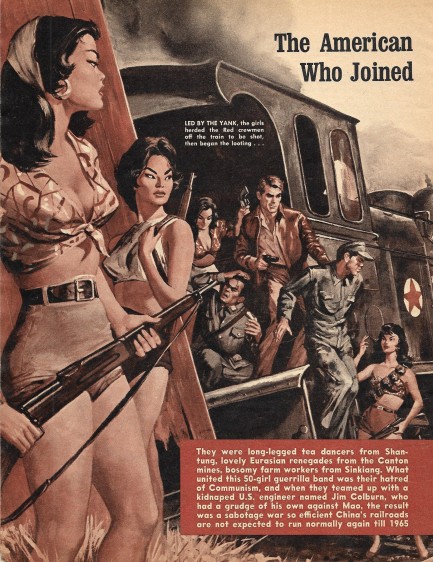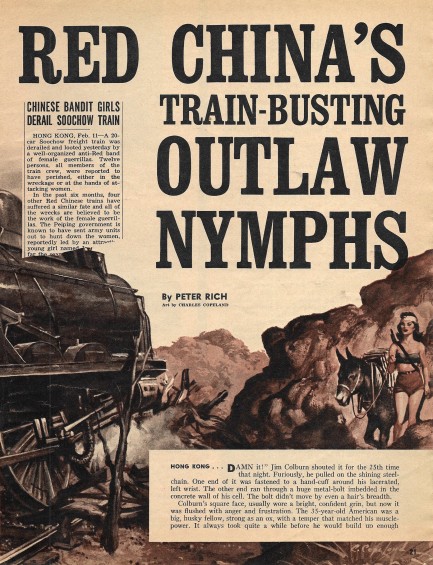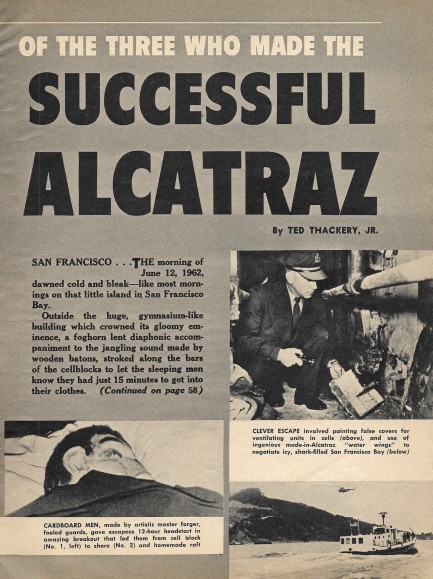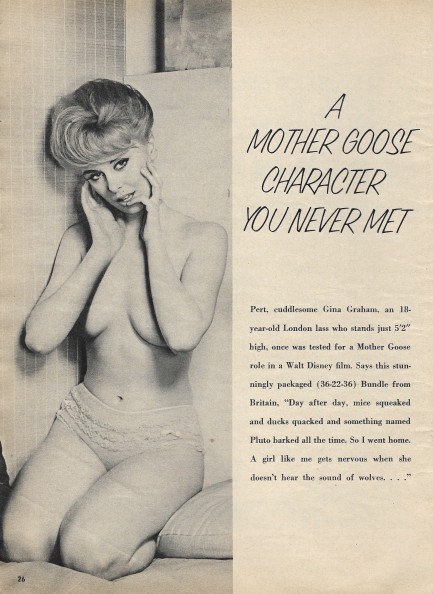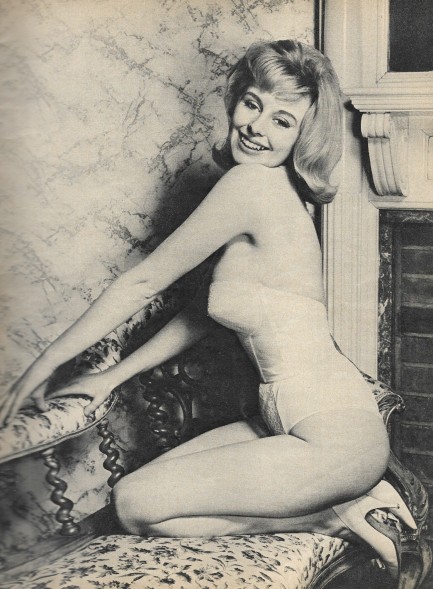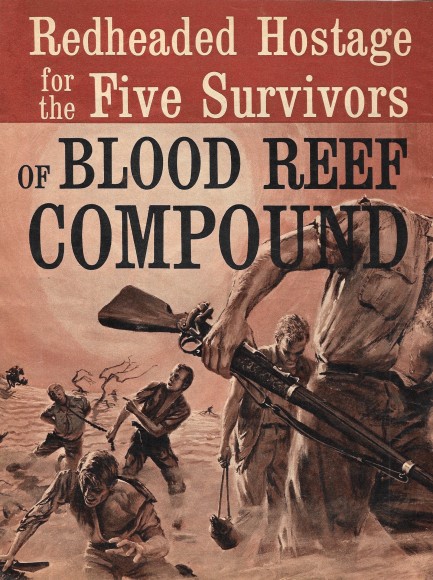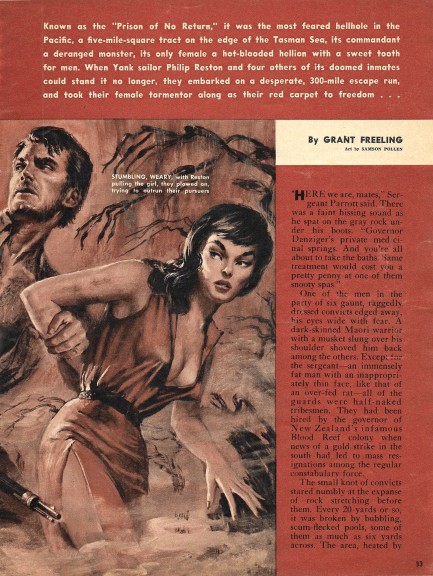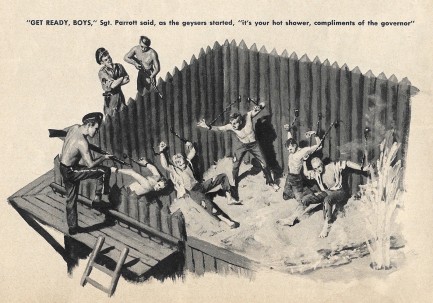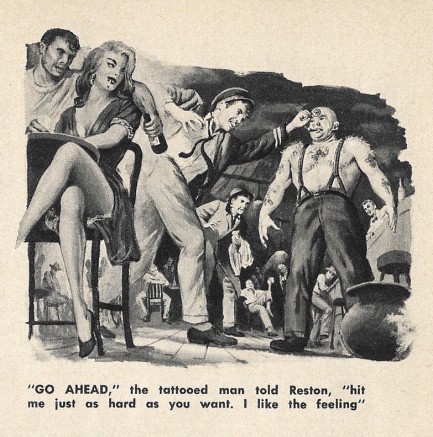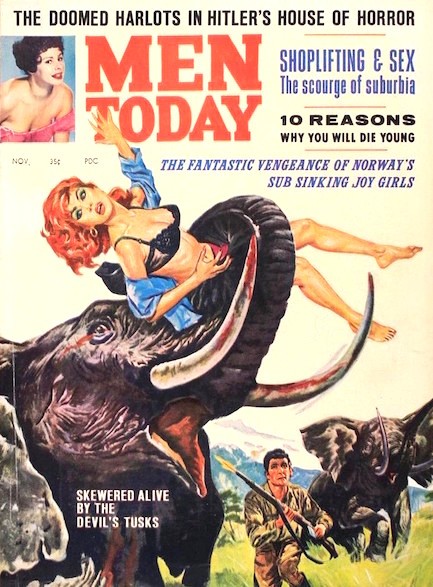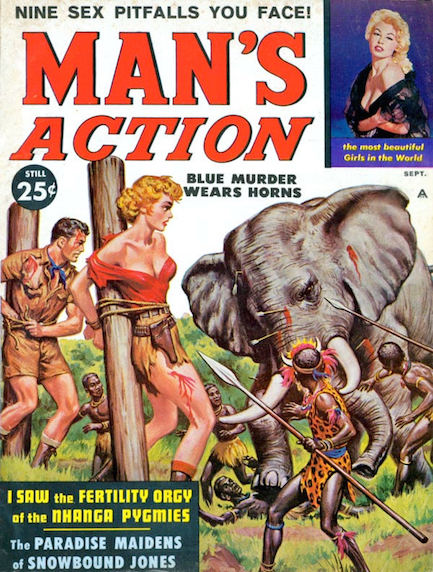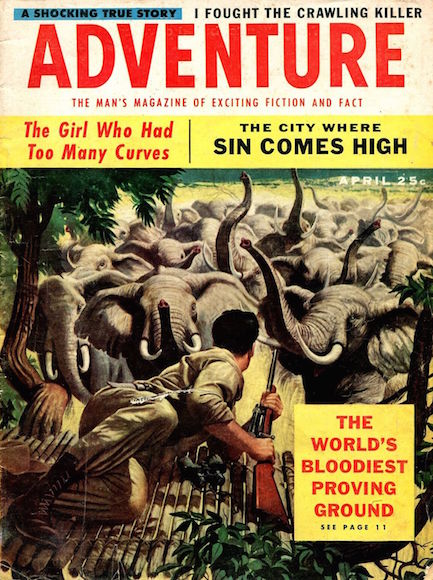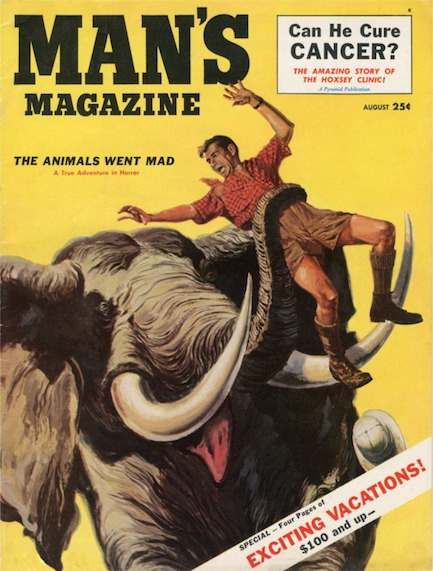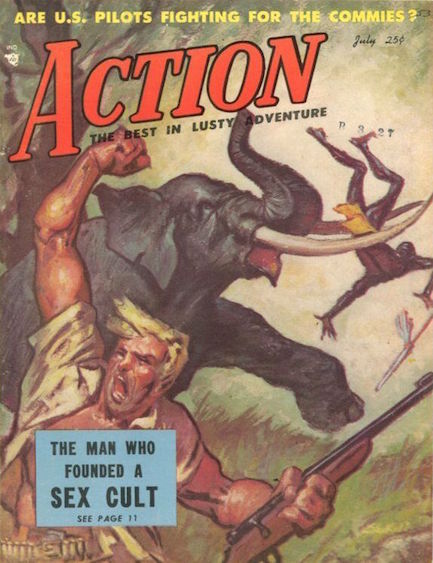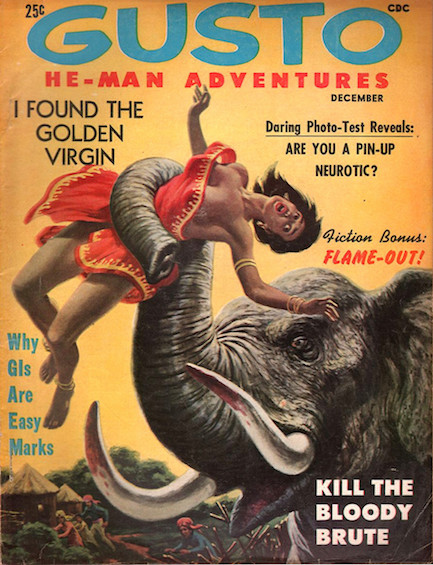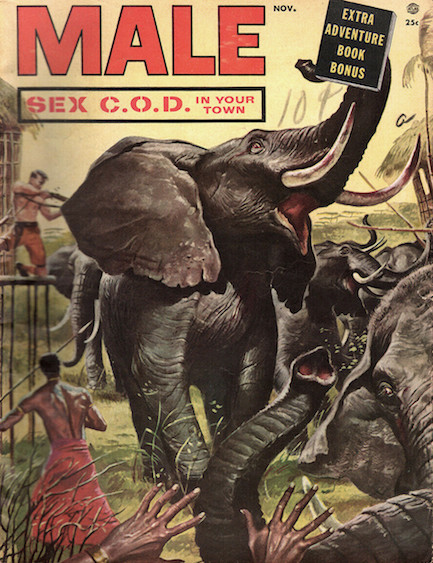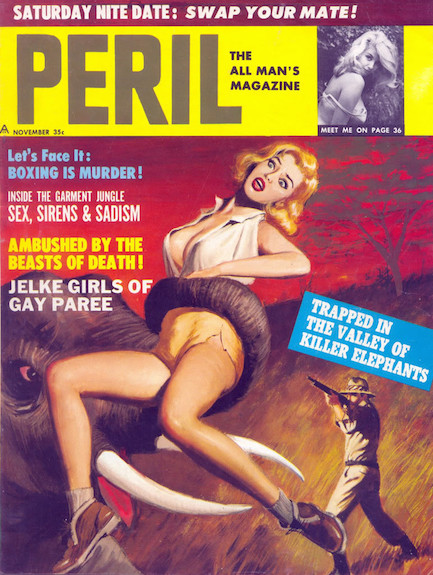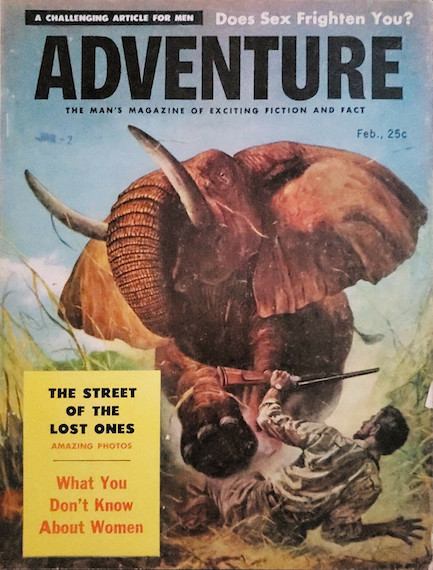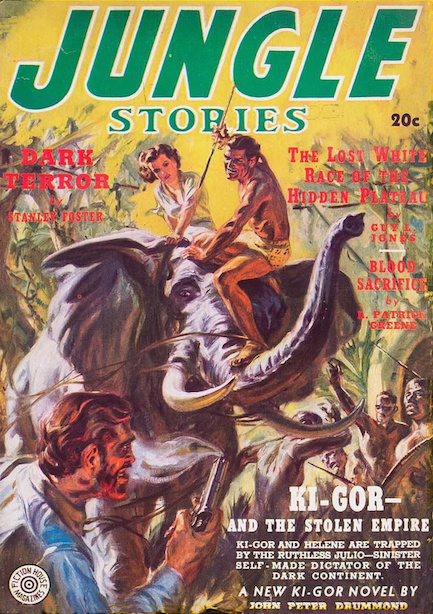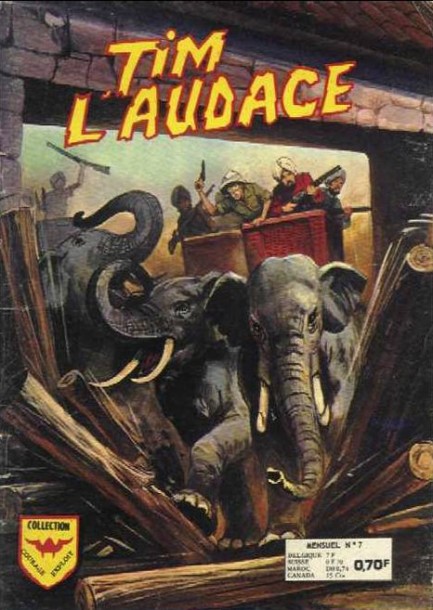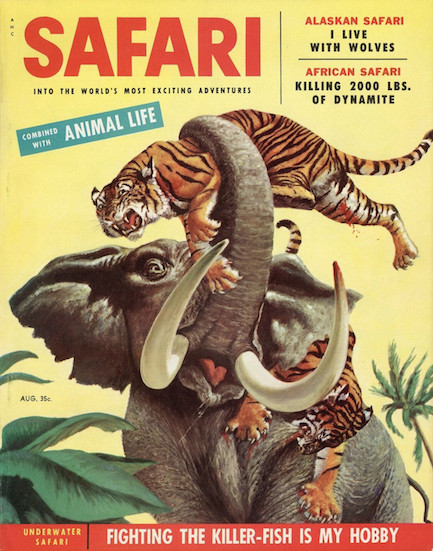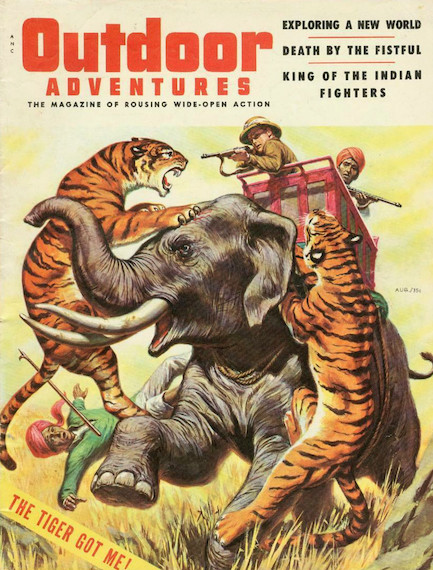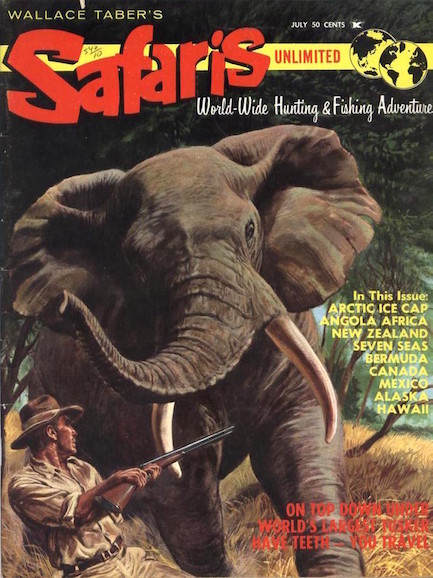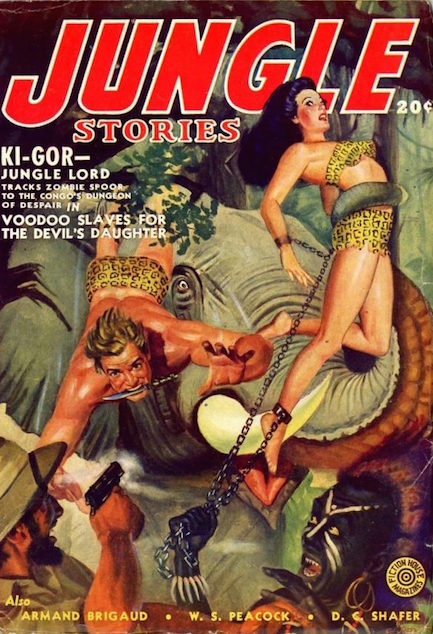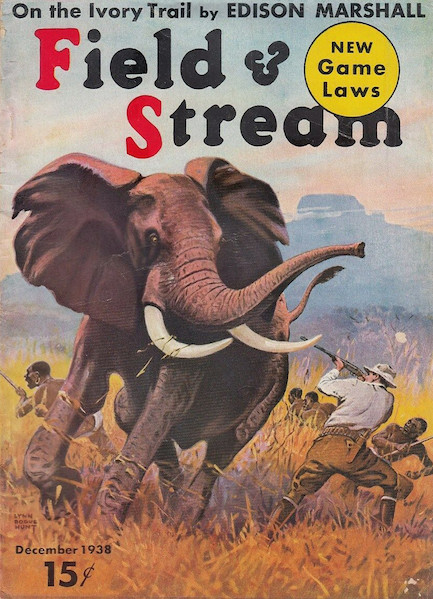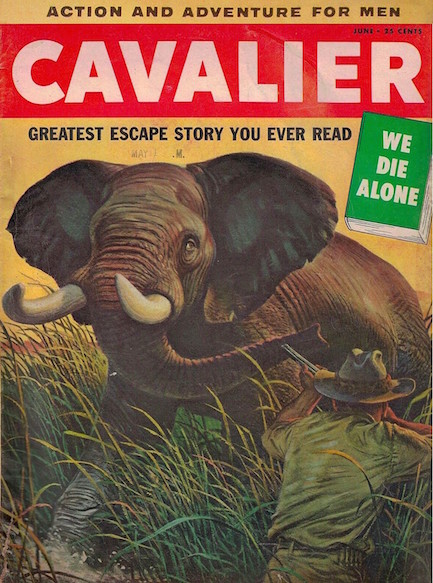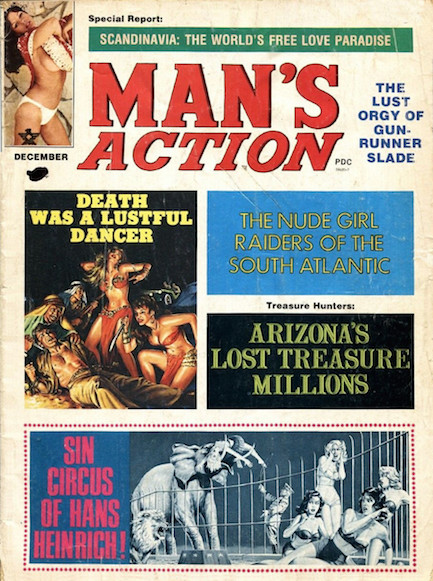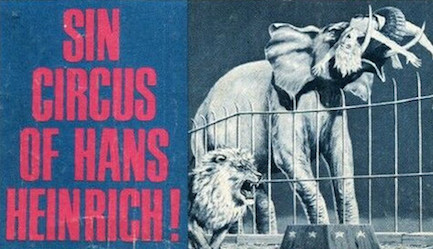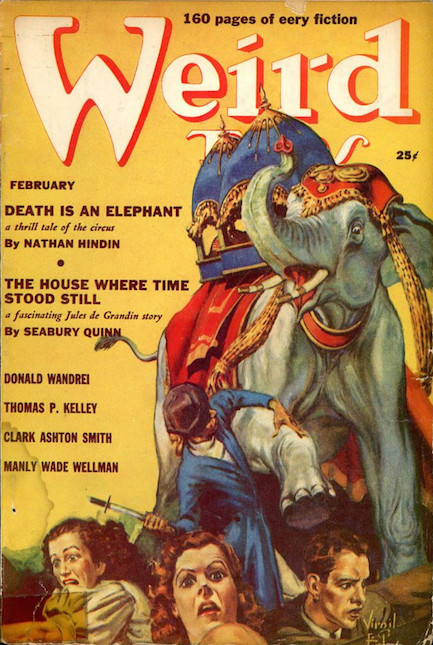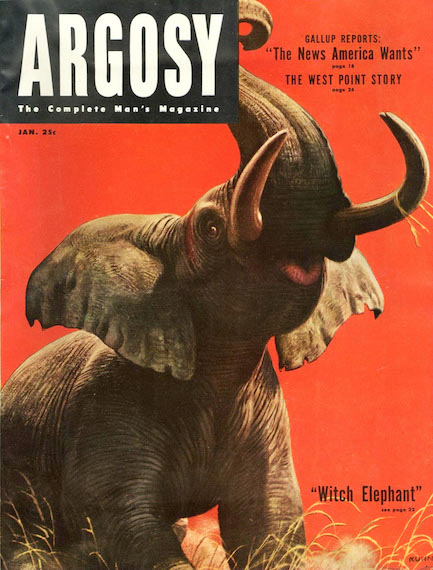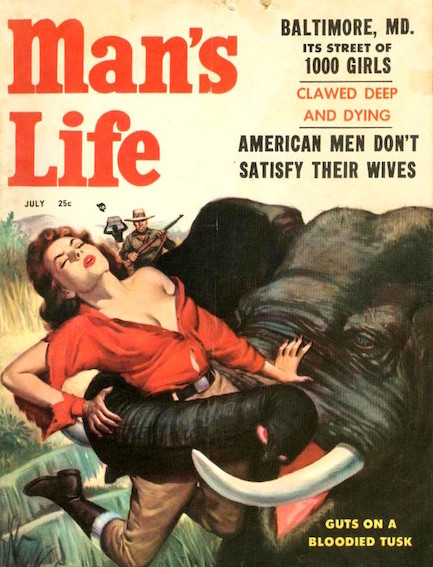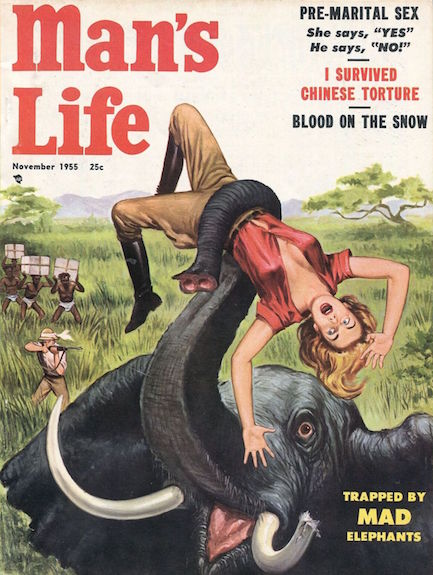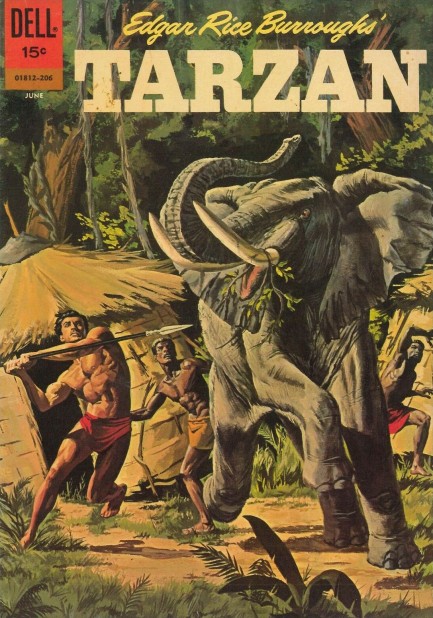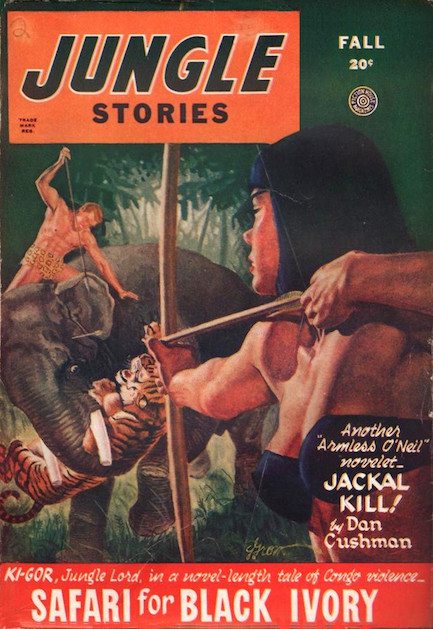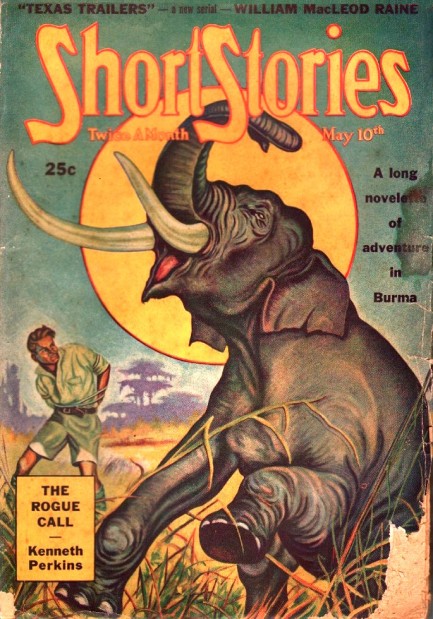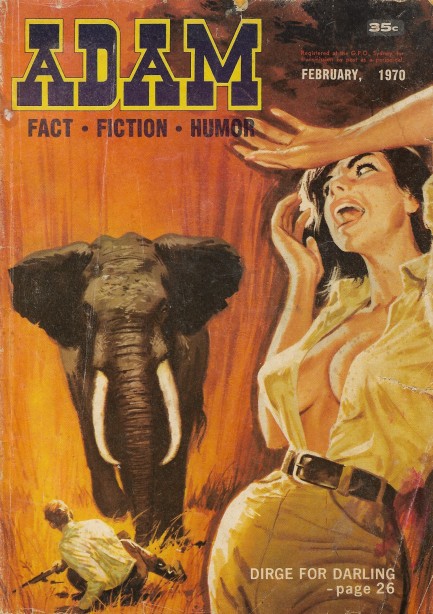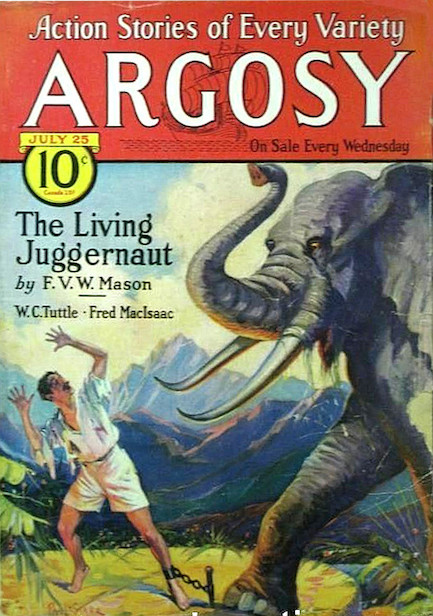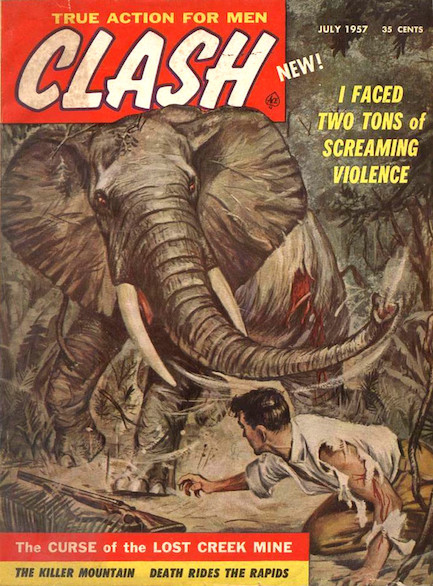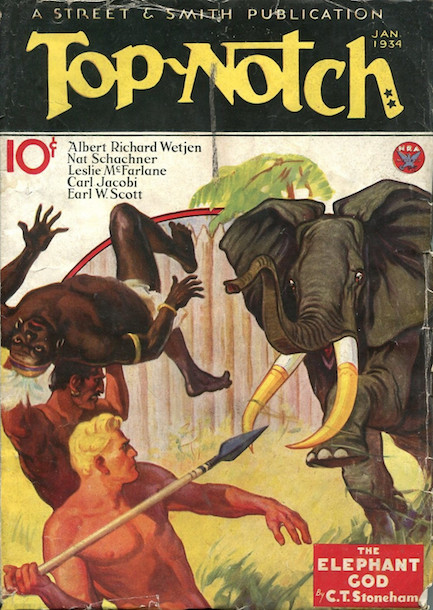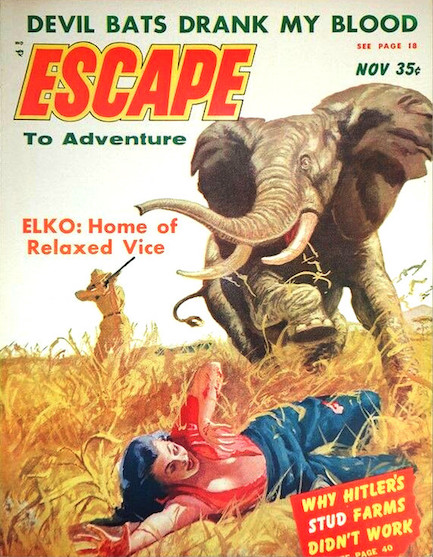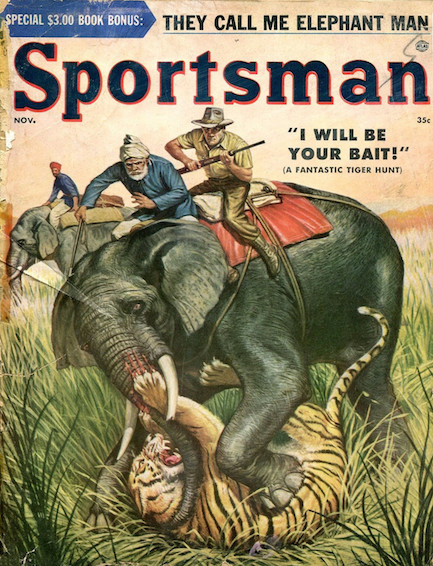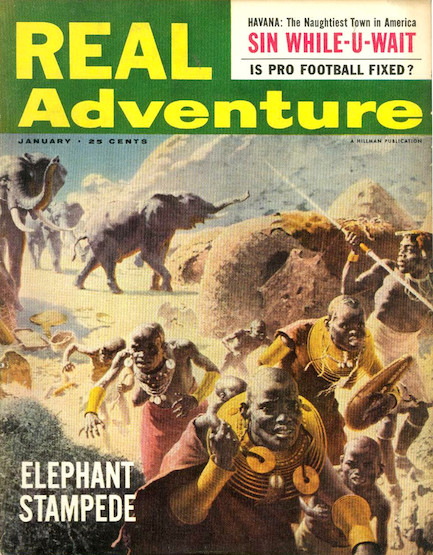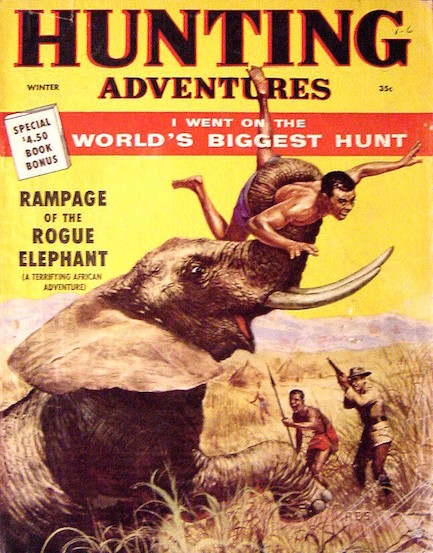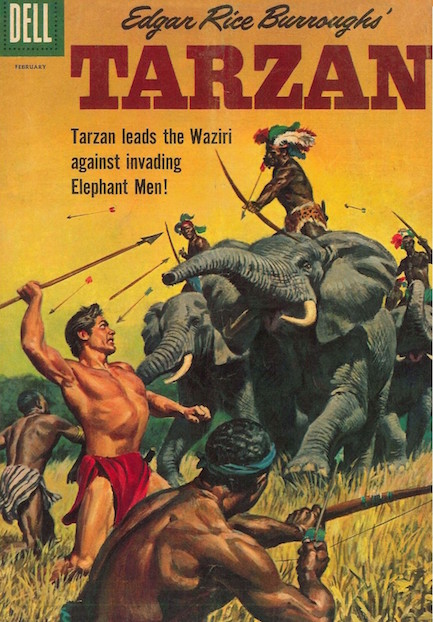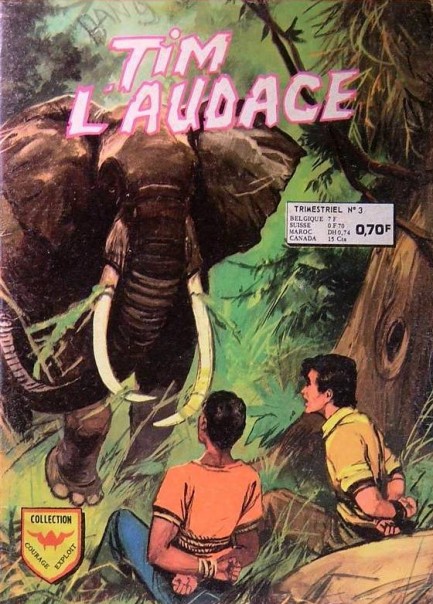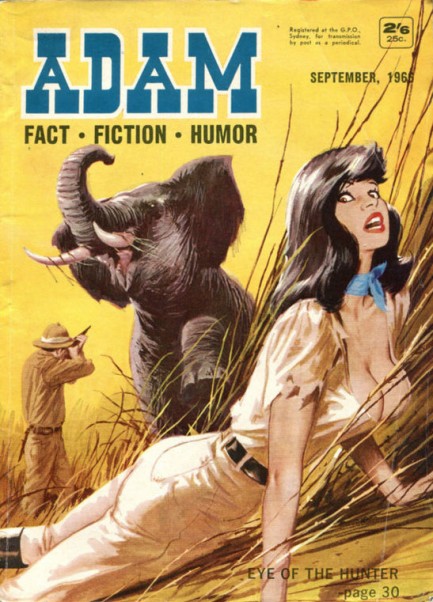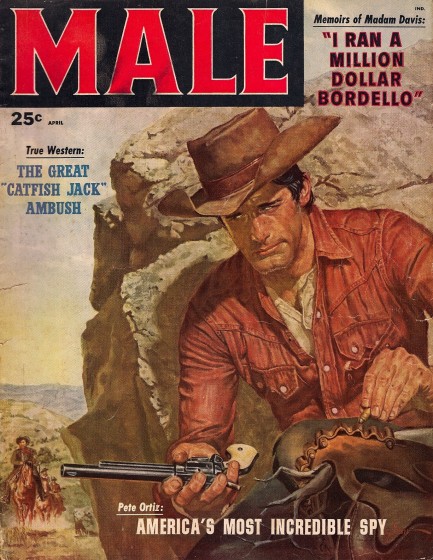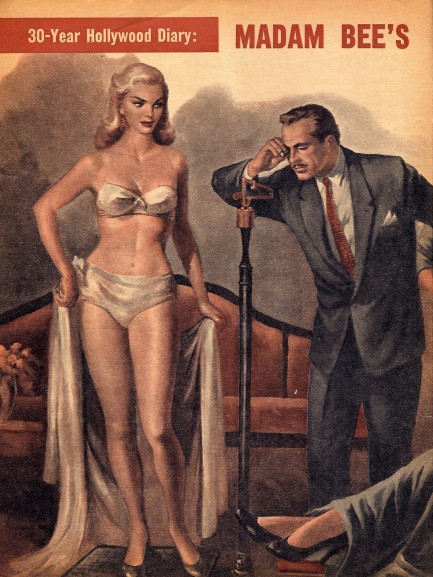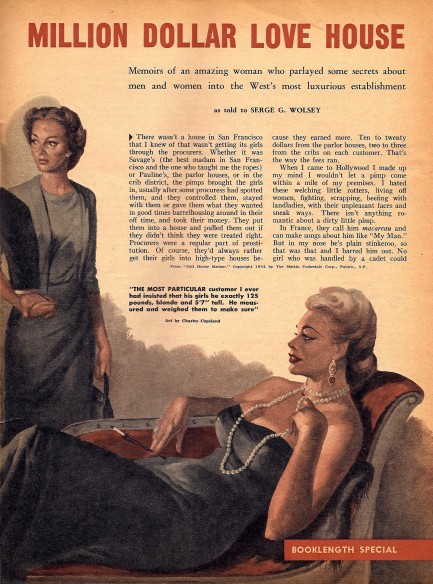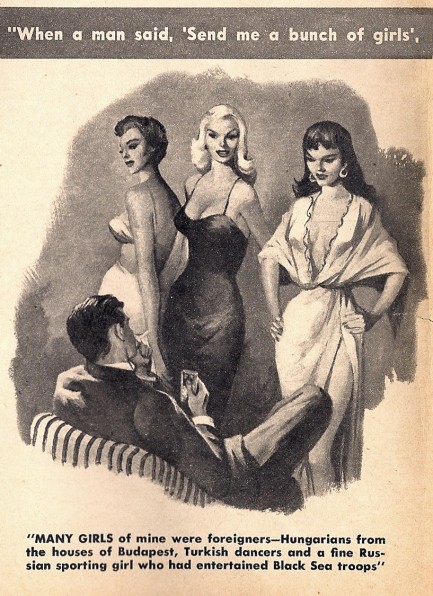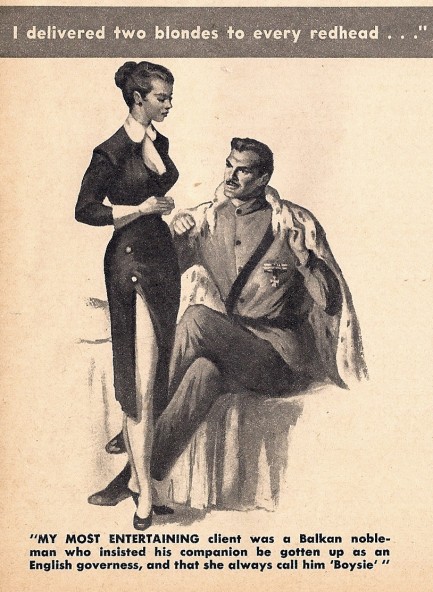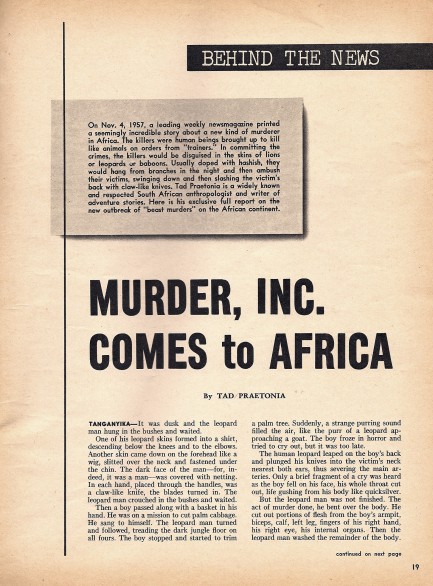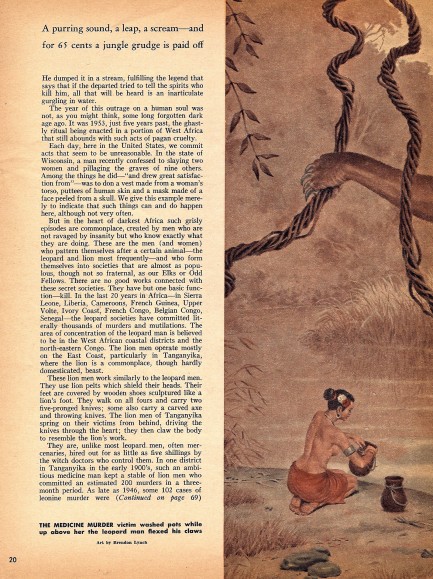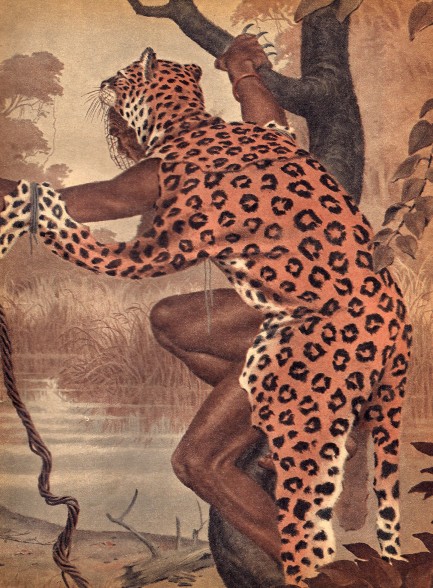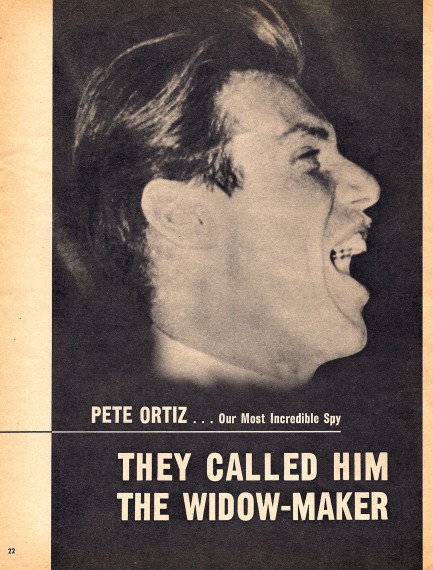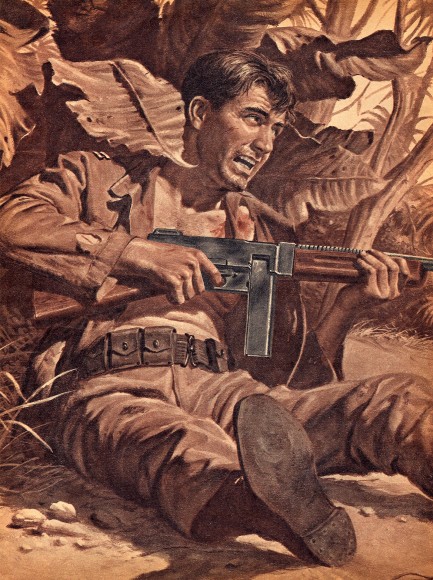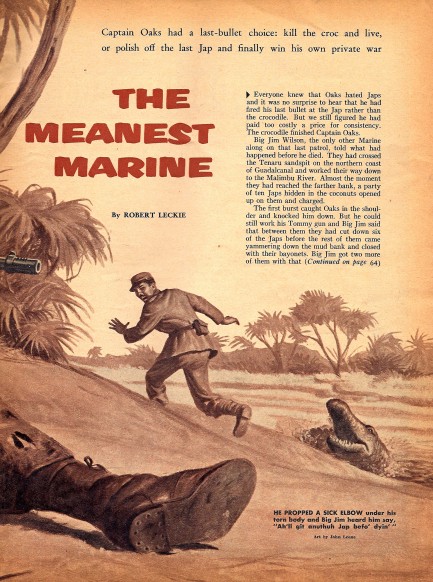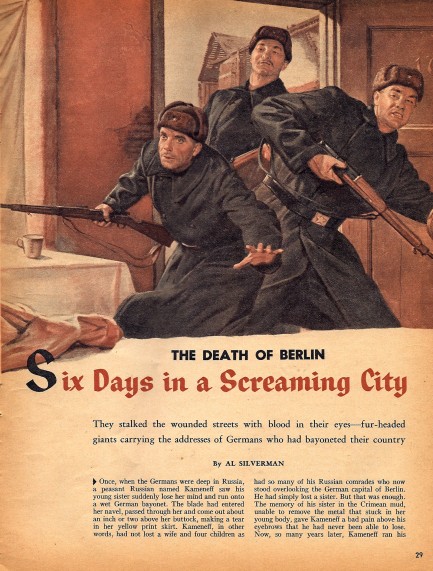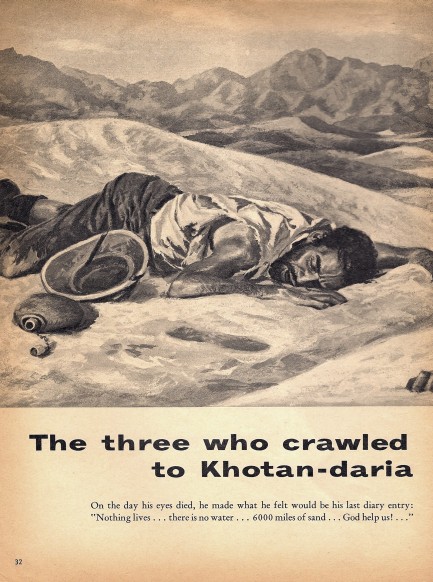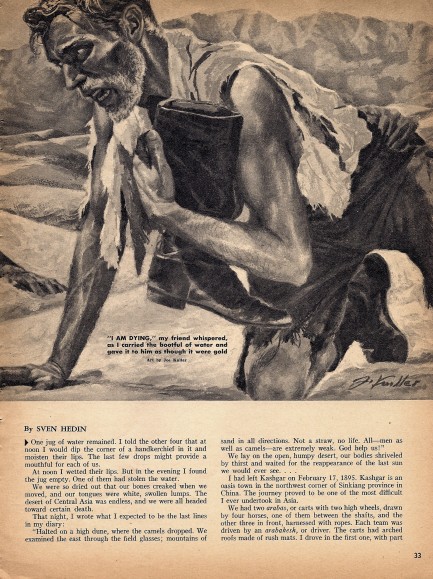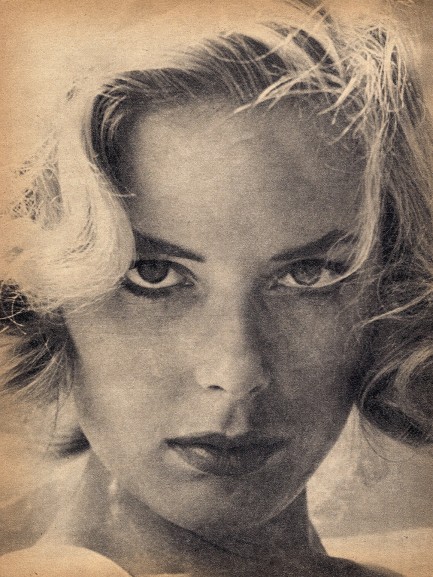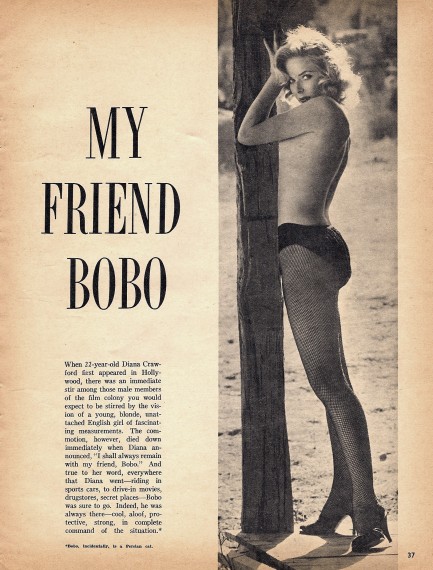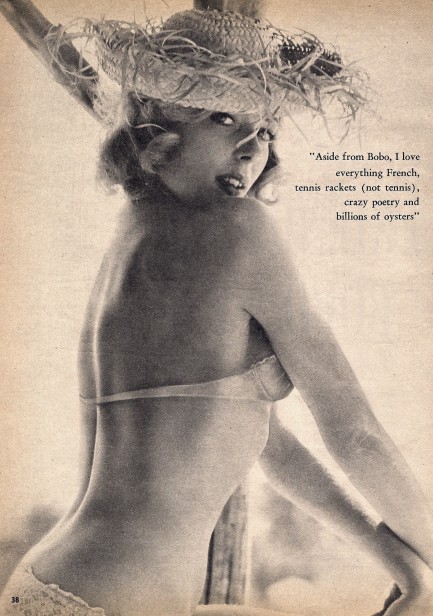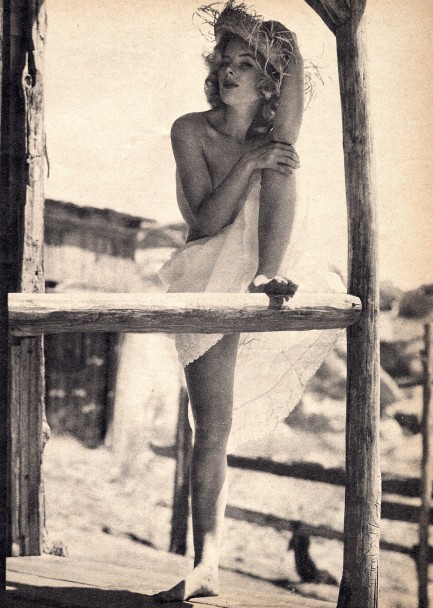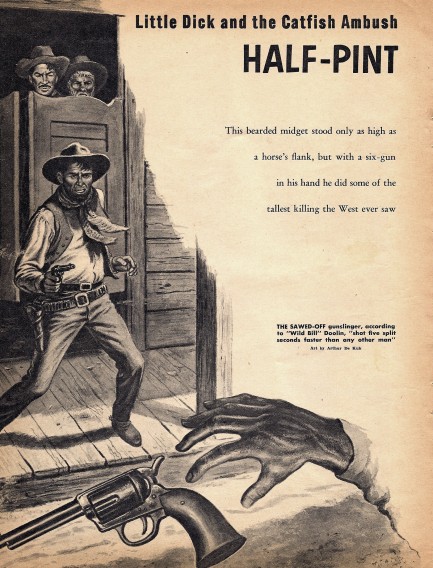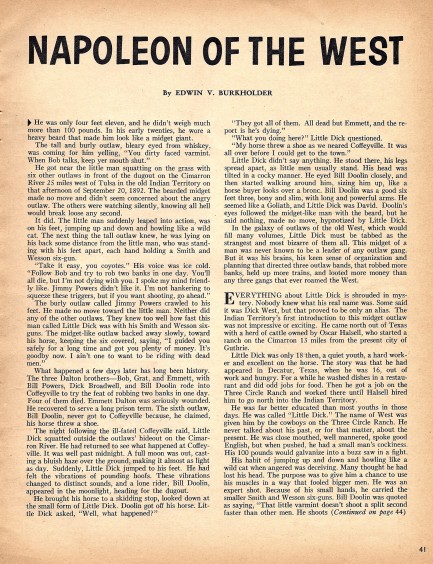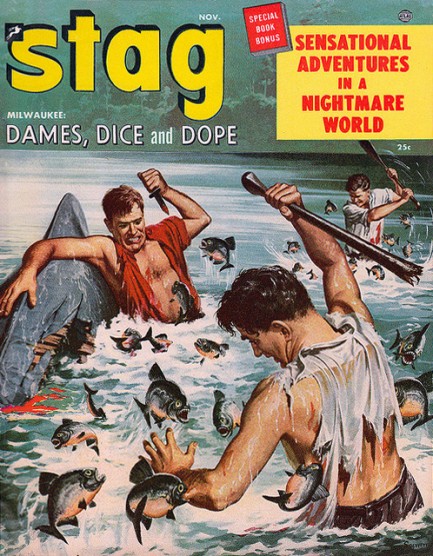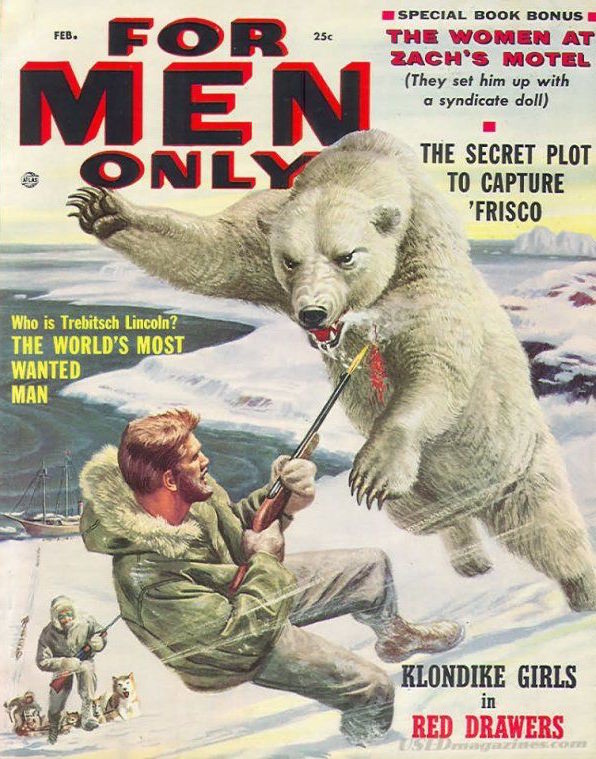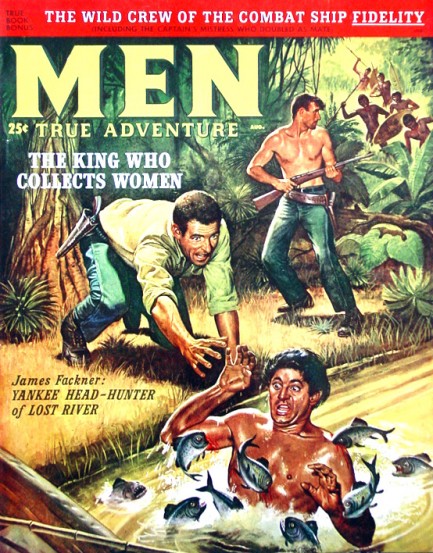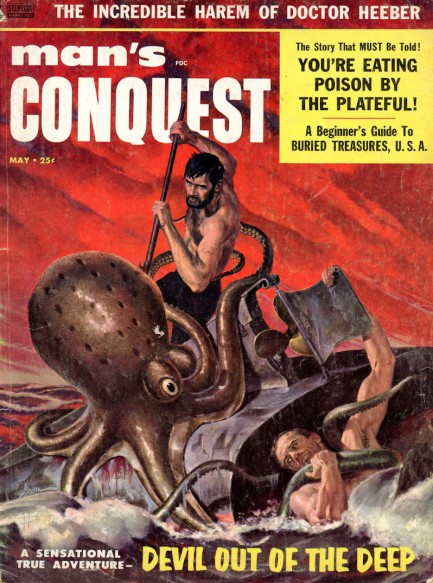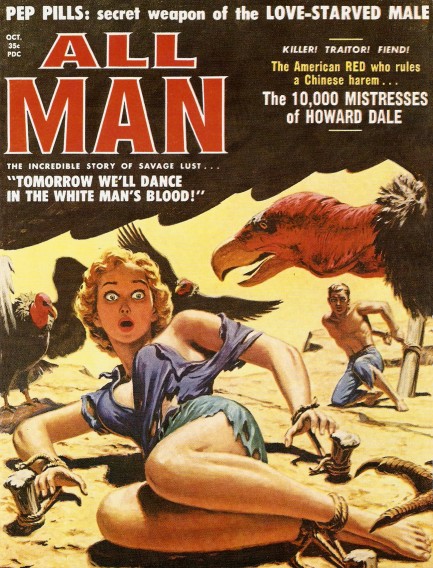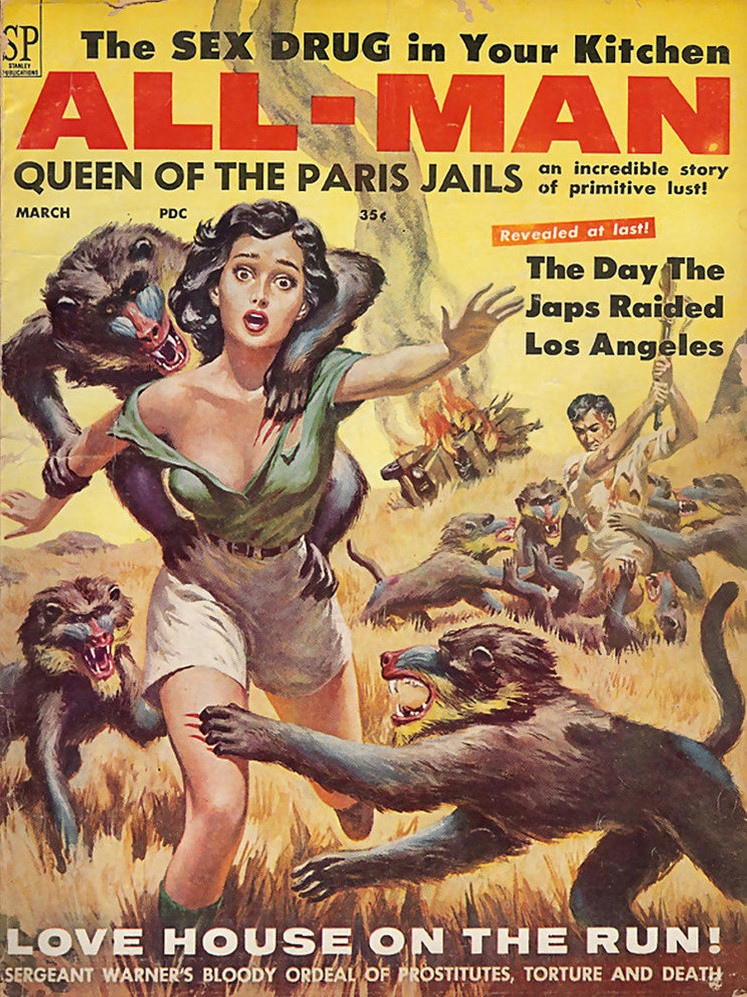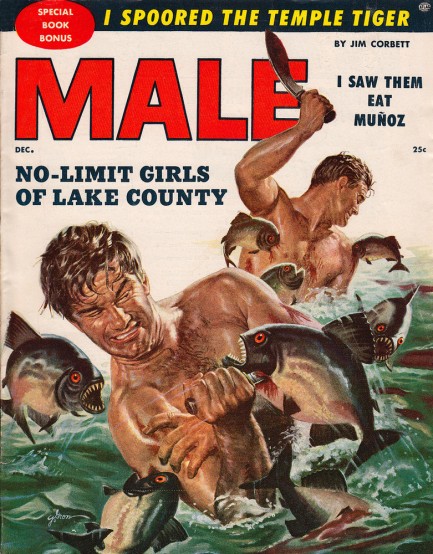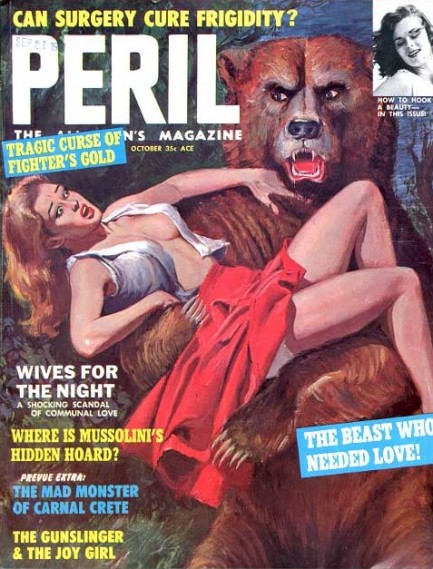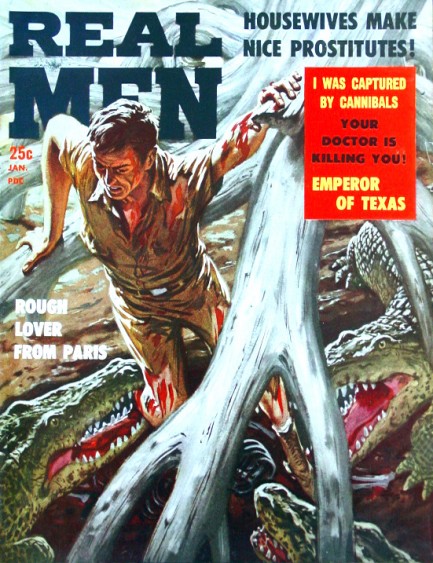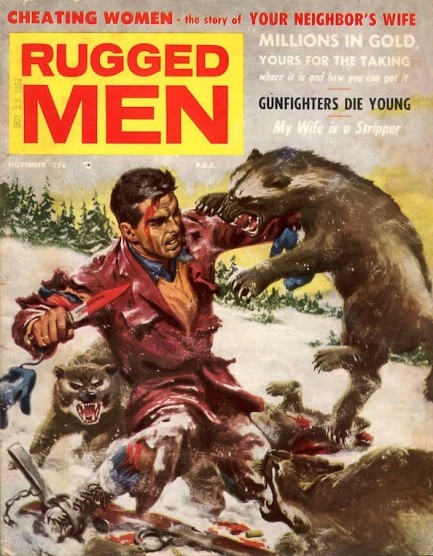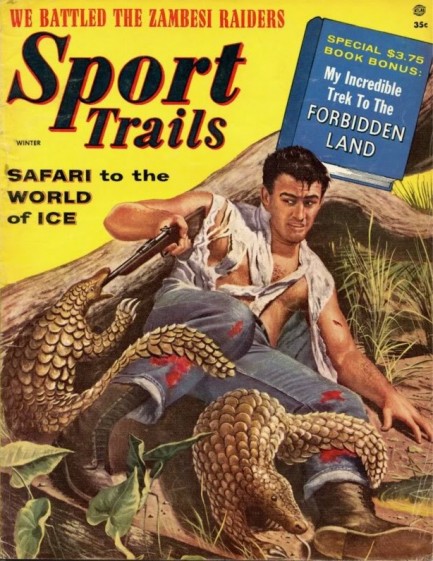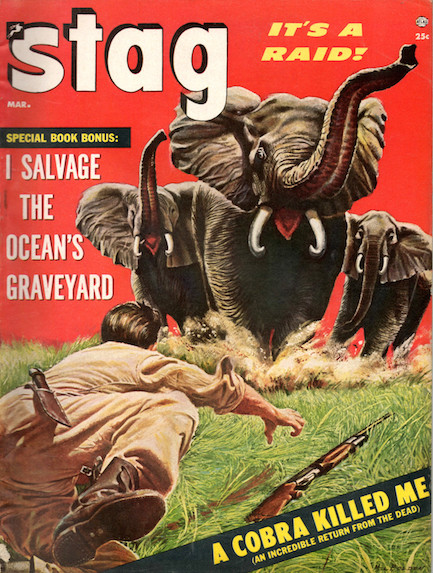 It's not comfortable, but it's reliable. 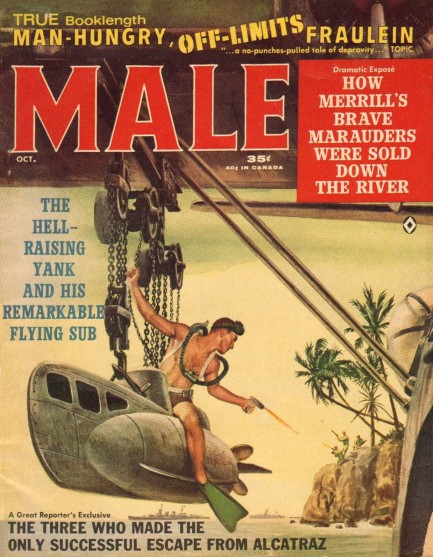
We're back to men's adventure mags today with an issue of Male from this month in 1962, with cover art by Mort Kunstler illustrating the tale, “The Hell-Raising Yank and His Remarkable Flying Sub.” We gave the story a read and it tells of Walter R. Cook, a U.S. soldier stranded in Burma who, with the aid of a local beauty (of course), finds and refurbishes an abandoned Catalina seaplane, which has attached to it a two man submarine. The sub was a type used during World War II that the operators rode like horses while breathing through scuba gear. Cook uses it to disrupt Japanese supply lines.
The story is a standard sort for an adventure magazine, but educational, since we'd never heard of rideable submarines. The illustration makes clear exactly what form it took. The magazine also offers stories set in China and New Zealand, and contains a detailed piece on an escape from Alcatraz, the very escape that inspired the Clint Eastwood film Escape from Alcatraz, involving the inmate Frank Morris, who may or may not have actually succeeded. The art throughout the issue is from the usual suspects—Charles Copeland, Samson Pollen, and Bruce Minney—and is tops as always. We have seventeen scans below.
 Leave it to Nazis to turn phys ed from your favorite class into the worst experience of your life. 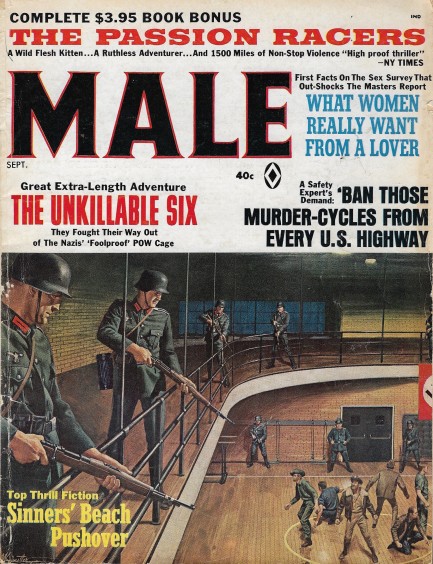
This cover of Male from this month in 1967 has cover art of history's worst gym class, painted by the great Mort Kunstler, and leave it to Nazis to ruin the one thing you can get a good grade in just by showing up. Another thing ruined is the magazine. When it arrived it turned out some pages were razored out of the center. Probably the most interesting pages. It's an occupational hazard, we suppose. We generally assume the seller had no idea, as these mags are so often the leftovers of fathers and grandfathers, but if it was in fact deliberate, well then, cocks on their house! That's the saying, right? Or it pox? Doesn't matter. The silver lining was that we didn't have to worry keeping the magazine intact while scanning. We just ripped it apart, which sort of felt good.
There's still plenty of interesting material inside this mutilated Male. There's fiction and fact, art from Gil Cohen and Bruce Minney, plus more from Kunstler, a screed against motorcycles, a lot of pro Vietnam War content, with lots of digs at peace activists and draft fugitives. The magazine works especially hard to convince readers that draftees who fled to Canada faced lives worse than if they'd gone to Southeast Asia. We doubt quite seriously that anything could be worse than dying in a hot jungle for no rational purpose 10,000 miles from home. But maybe we're biased—our fathers were war vets, and they had one wish in life: that the military never get its mitts on us. Also that we never do hard drugs. Well, one out of two isn't bad. Twenty scans below. 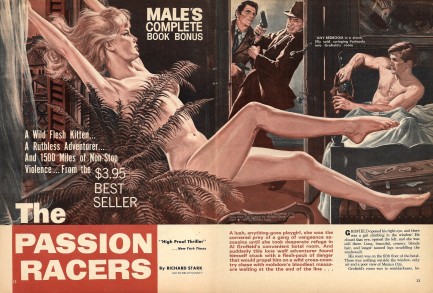 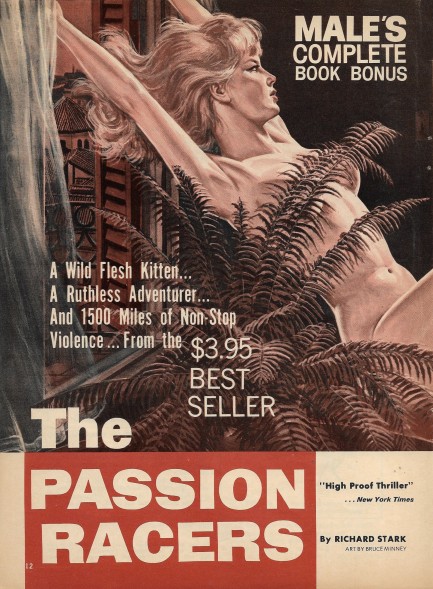 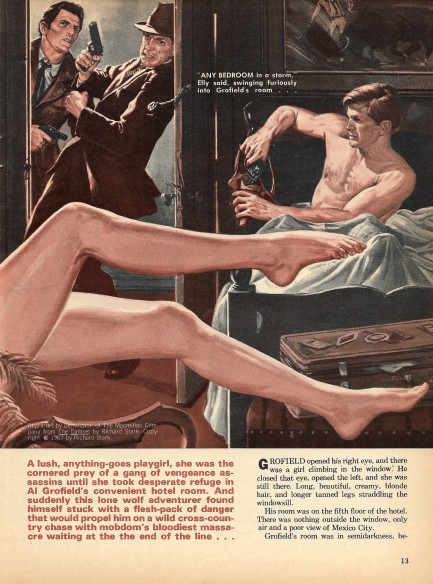 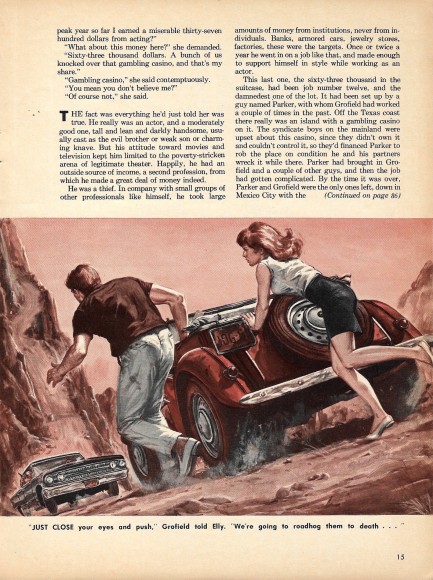 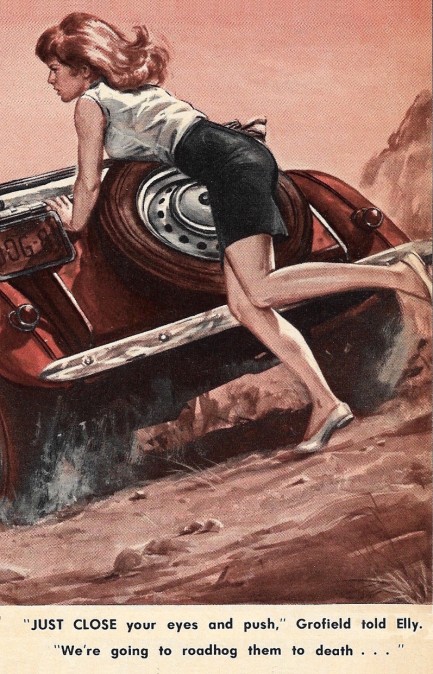 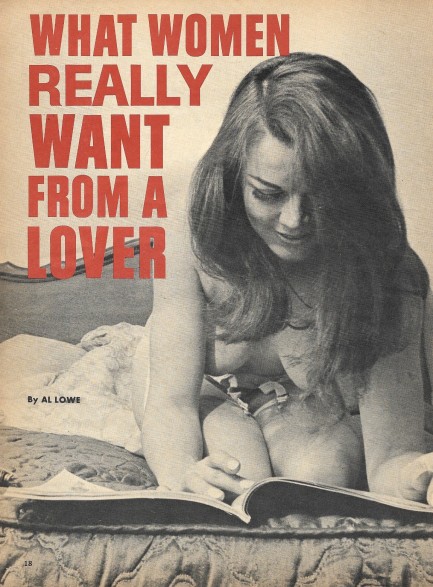 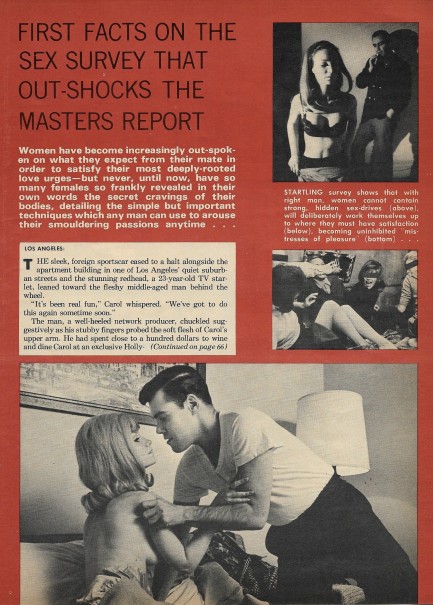 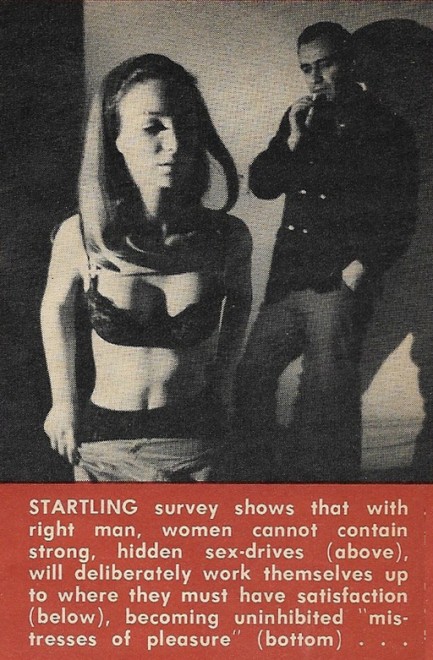 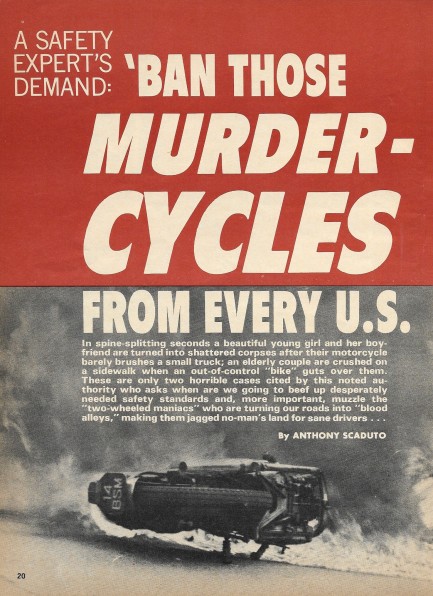  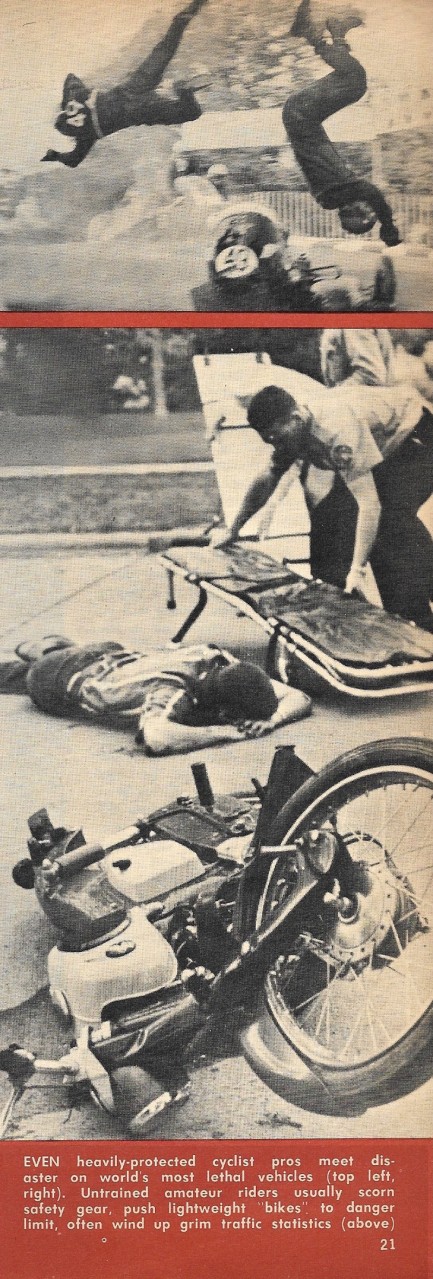 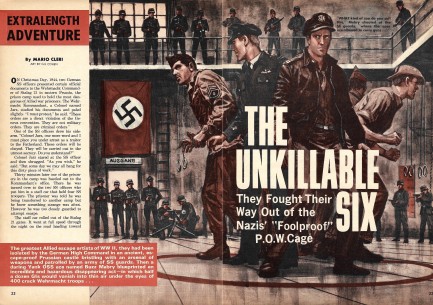 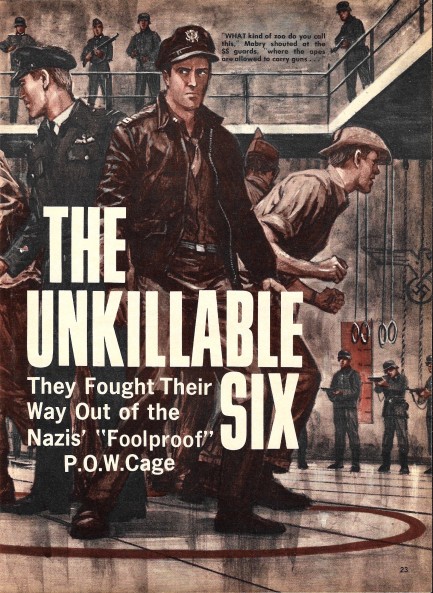 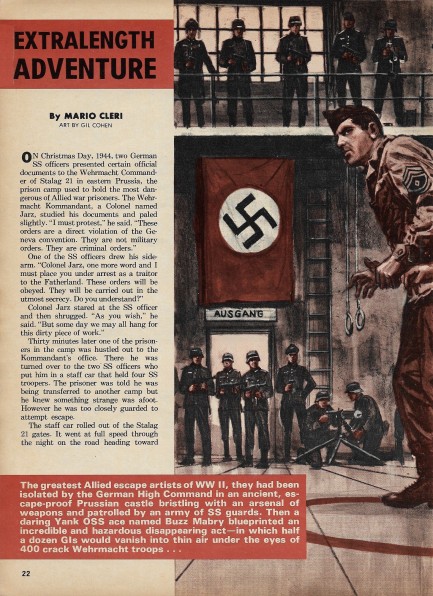 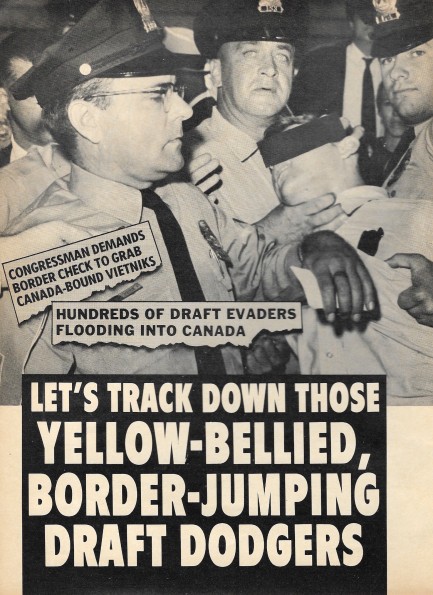 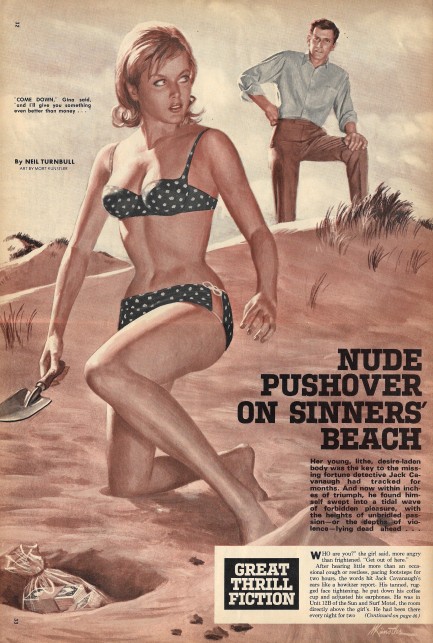 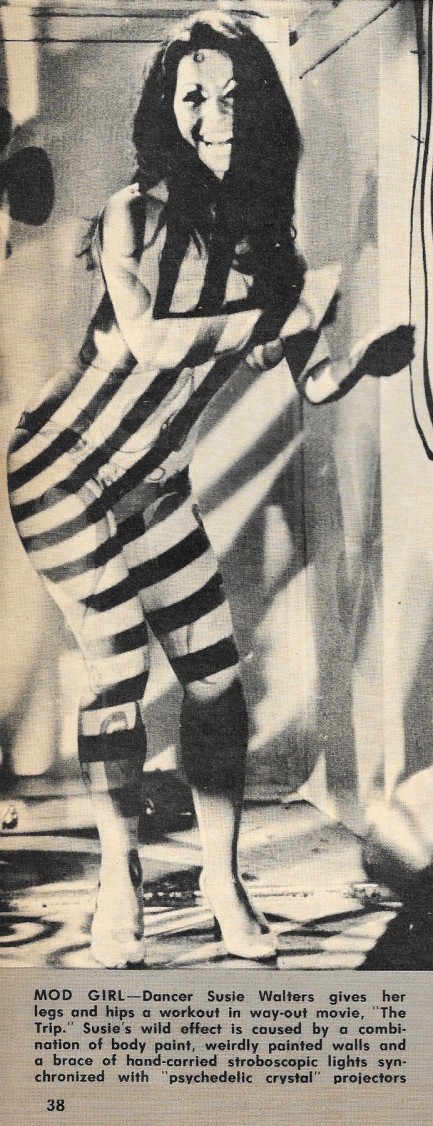 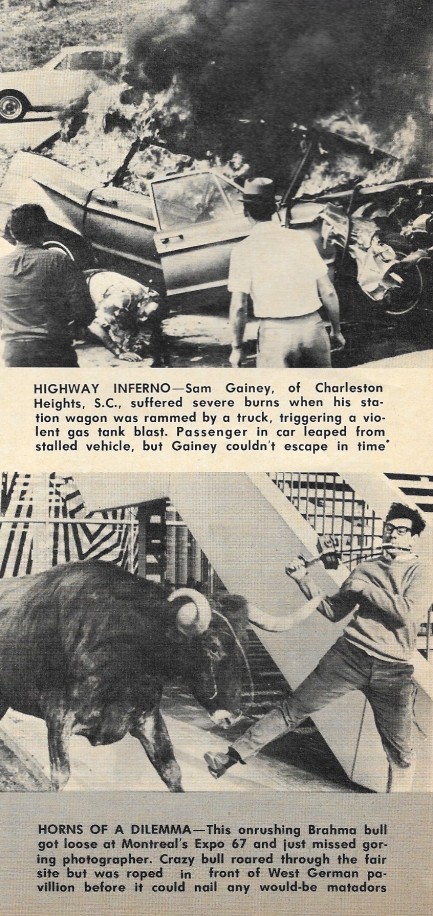  
 That's right, I'm looking at you. Read this magazine and learn how to be a real man. 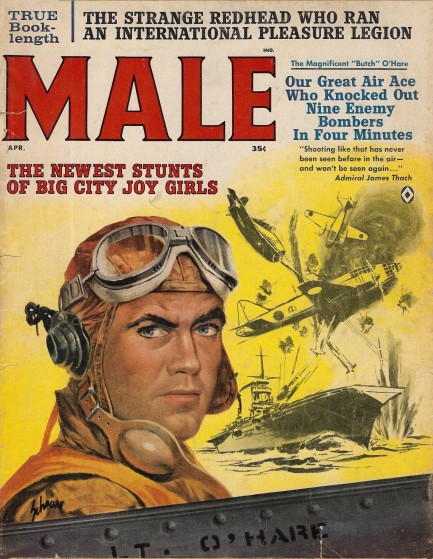
It seems to us that the purpose of men's adventure magazines was to teach ordinary schlubs a little something about how to keep it real, and this issue of Male published in April 1962 fulfills the mandate. Behind the steely-eyed cover art by Harry Schaare, and mixed between interior art by Charles Copeland, Rafael de Soto, James Bama, and Walter Popp, readers learn how to navigate big city vice, survive a nuclear attack, avoid appliance repair scams, pick the perfect car to cruise the open road, and—most importantly—get a raise at their soulsucking office jobs. Those are all fine offerings, but we particularly like the story, “Let's Let the Russians Beat Us to the Moon,” which suggests that if the Russians are so eager to get to the moon let them serve as sacrificial lambs—since the place is filled unknown dangers. Journalist and skeptic Ray Lunt reasons, “For all our scientists know, the moon may be 10,000 miles from where we think it is, paved with quicksand 90 feet deep, and full of brain gas instead of air.” Instead of air? Sounds like he was the one inhaling brain gas. We checked out the story just to find out what brain gas was, and learned basically nothing. He mentions that some scientists—unnamed of course—believe the moon might harbor poisonous gas, but the brain thing never comes up. What a tease. He does, though, run through a long list of other moon horrors fit for a Heinlein novel. He must have been really bummed in 1969 when it turned out to be just a big, dusty rock. We have scans below, and more Male in the website. Feel free to click the keywords. 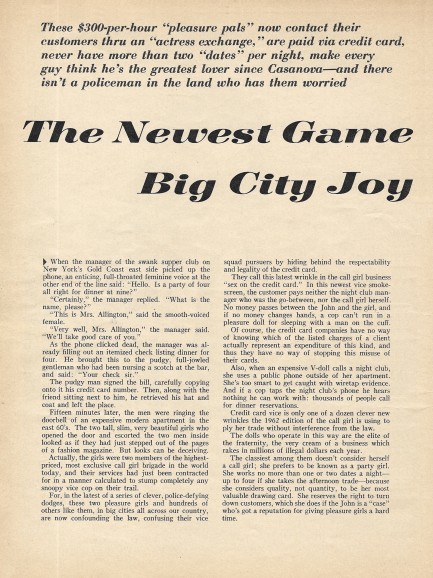 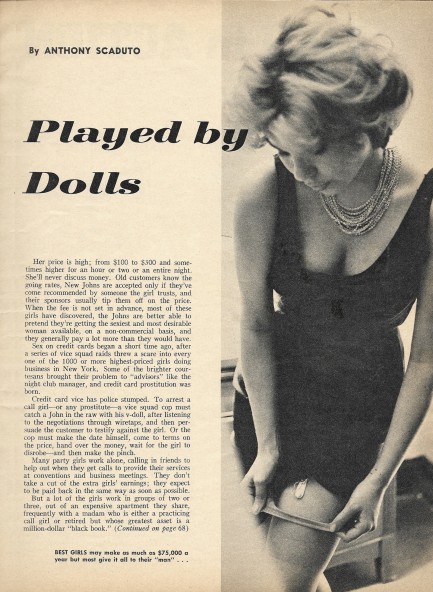 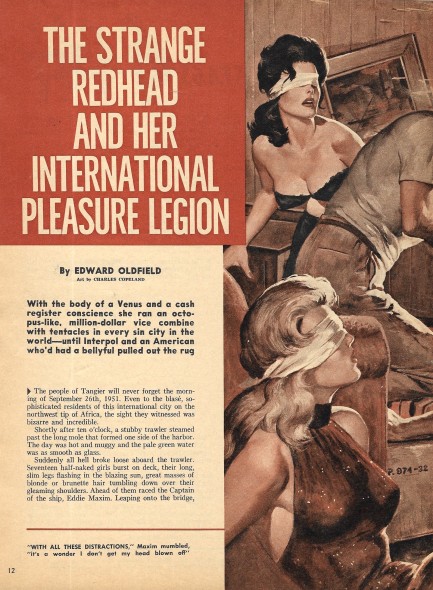 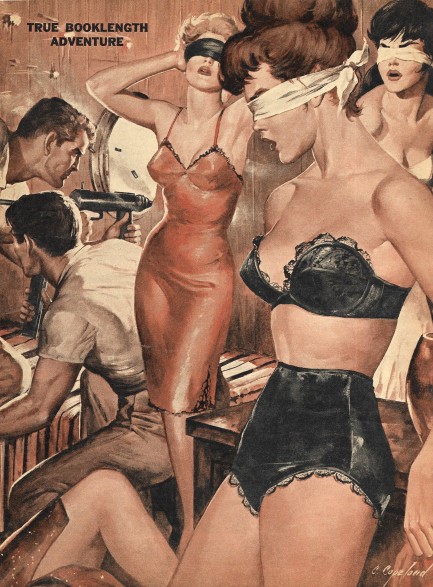 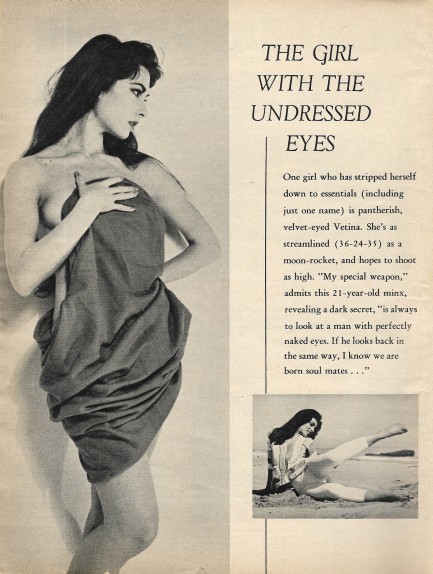 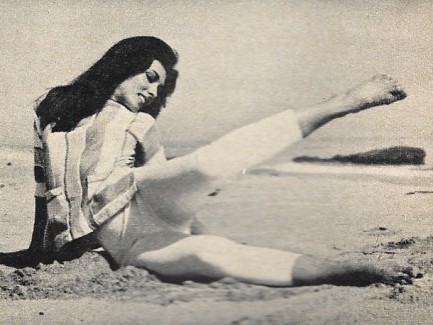 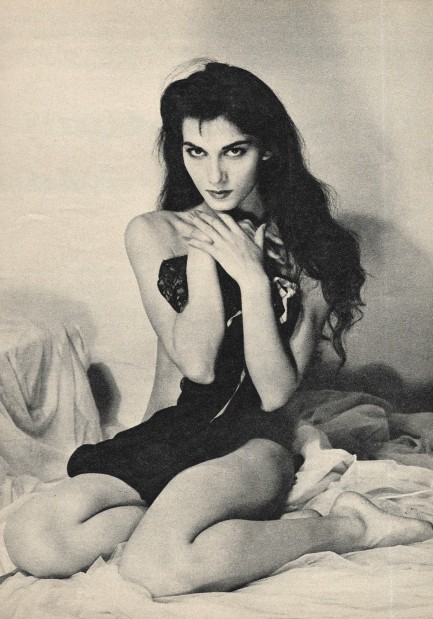 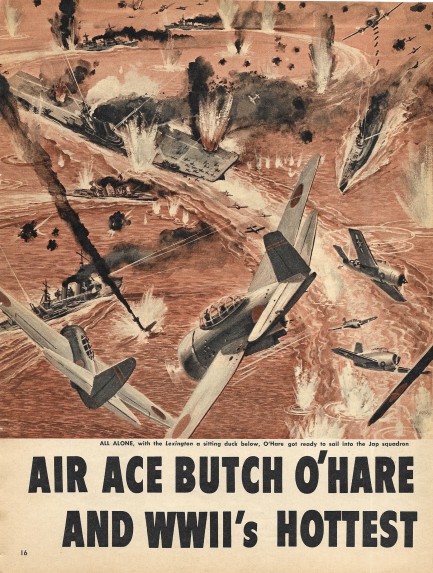 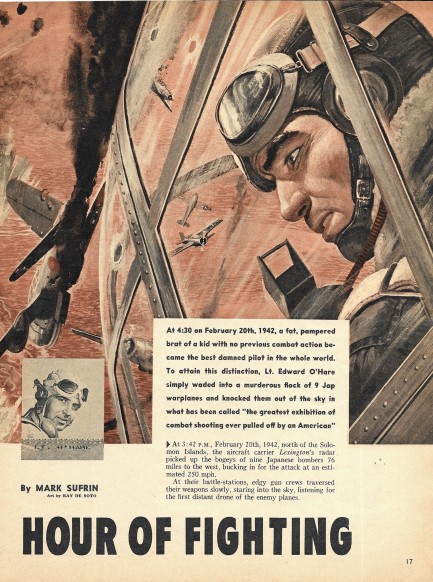 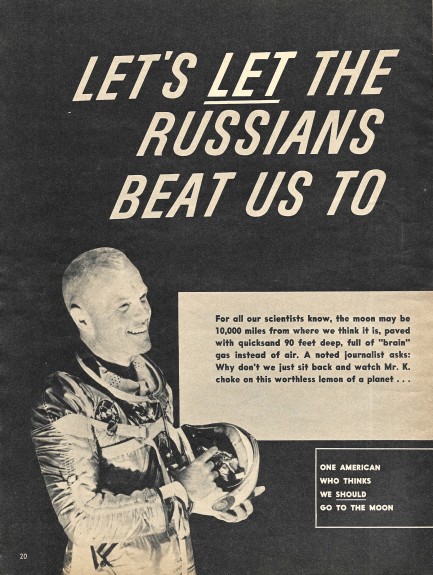 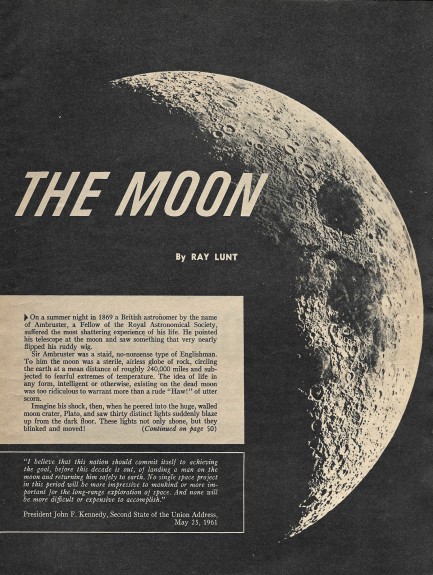 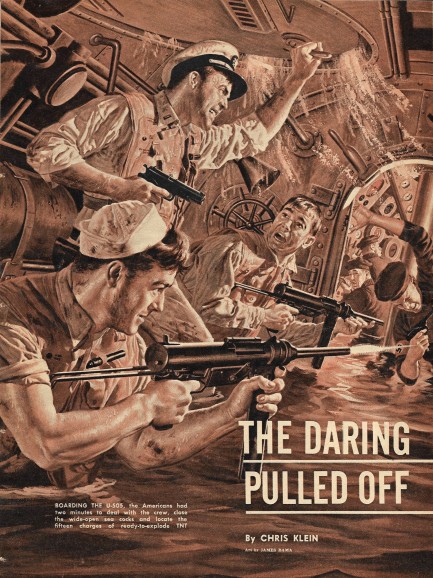 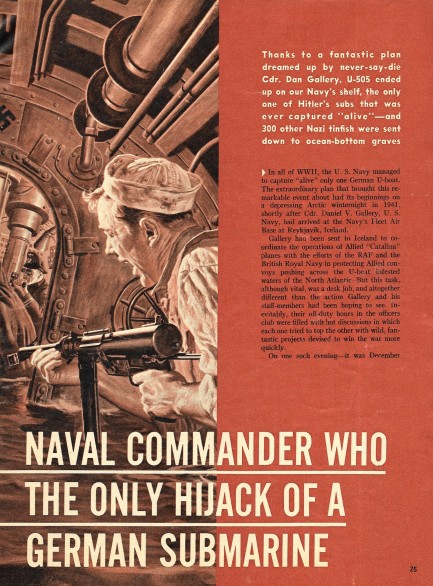 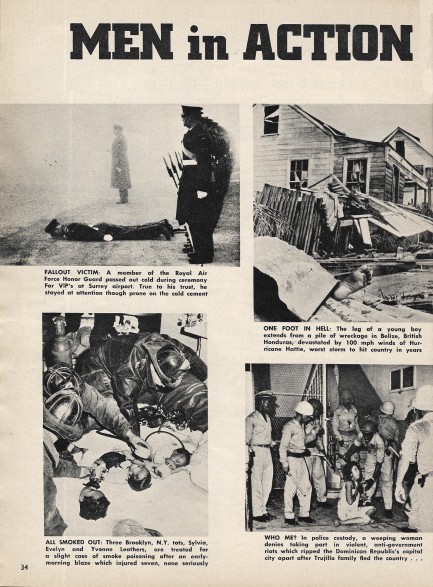 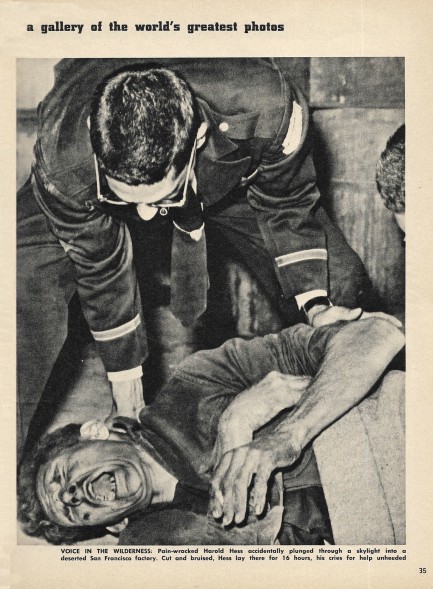 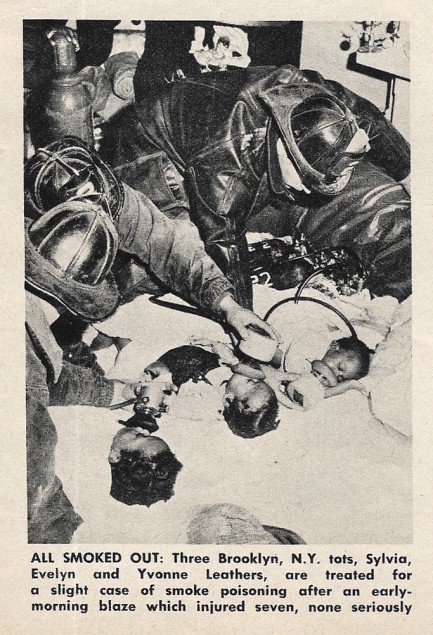 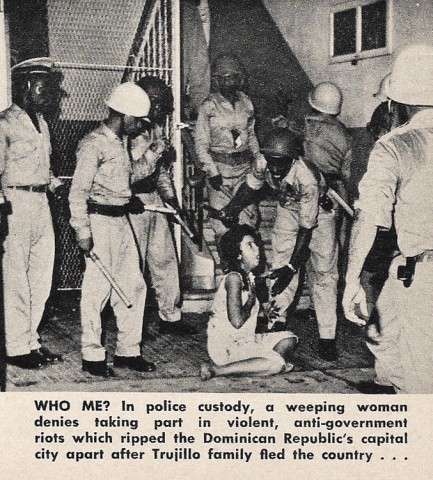  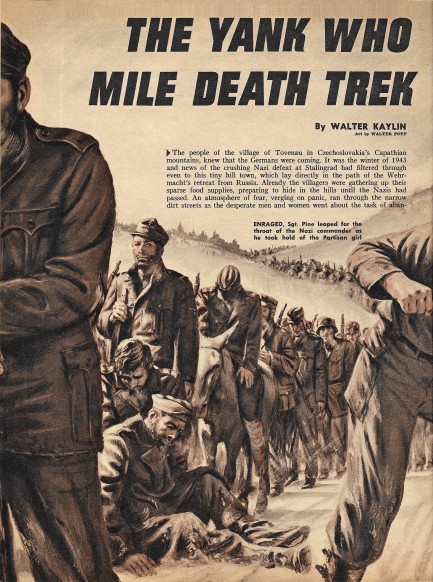 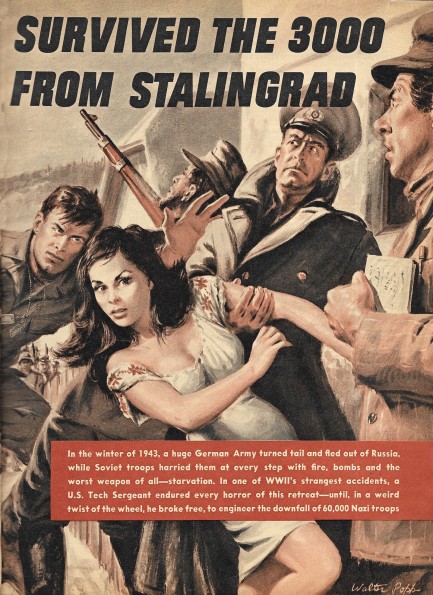 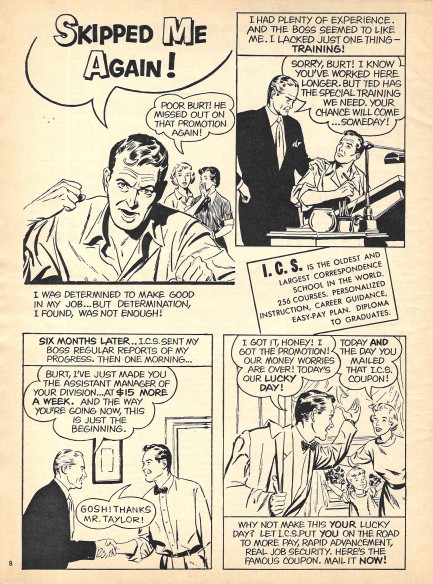  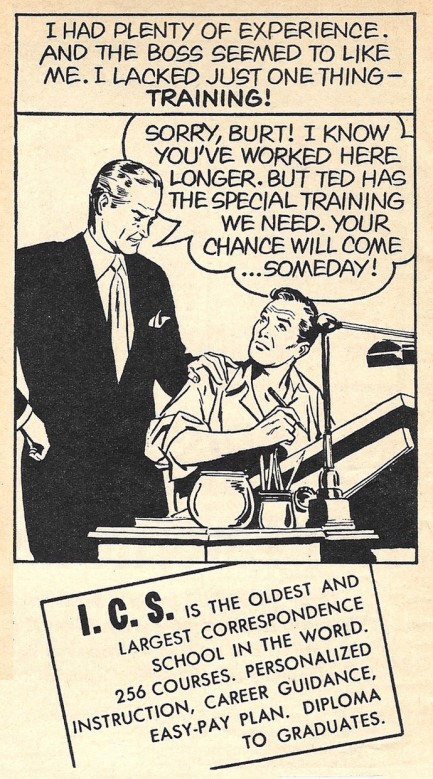 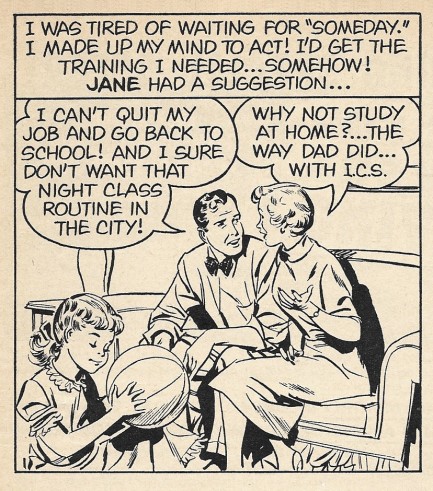  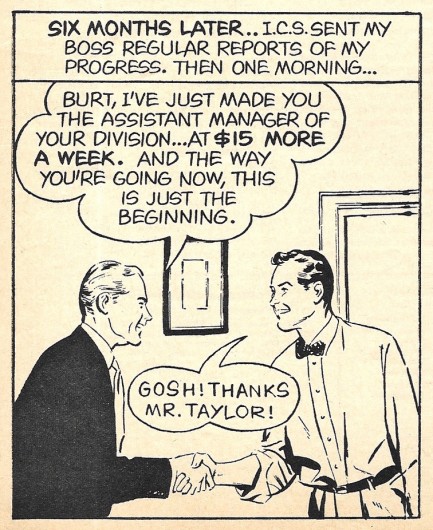 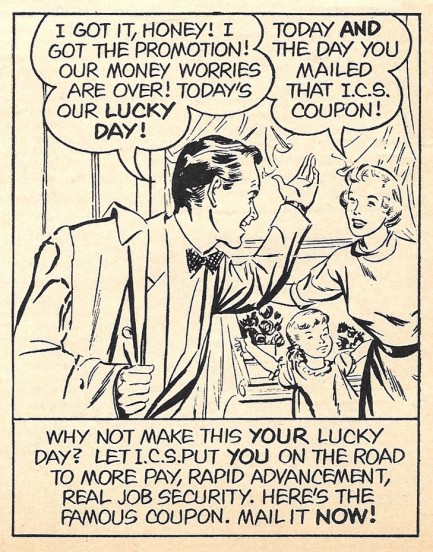
 Southeast Asia escape epic features murder, sex and everything between. 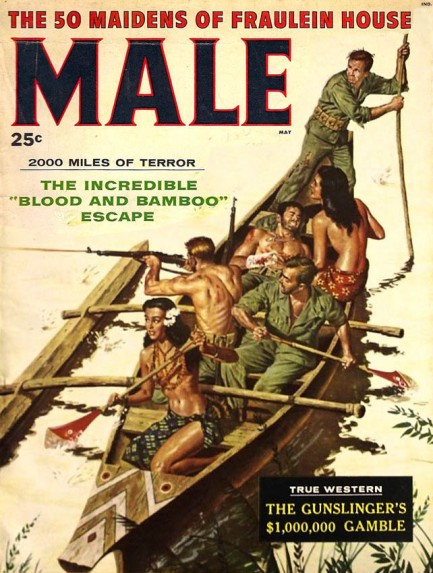
This issue of Male magazine published this month in 1958 features James Bama cover art illustrating Richard Farrington's story “The Incredible 'Blood and Bamboo' Escape,” which is the true tale of Dutchman Klaus van Tronk's flight from a Japanese internment camp in Malaysia during World War II. The story is a book-length special, and one of the more harrowing and interesting details involves one of the prisoners being tied spread-eagled on a bamboo mat elevated six inches above the ground. Beneath the mat were living bamboo shoots. As Farrington tells it (via van Tronk's account), “The shoots are tough, the tips as sharp as honed steel, and they can push through a plank floor [two inches thick]. They grow rapidly in the Pacific sun, about six inches on a good hot day. It had been a hot day.” When van Tronk's work detail came back that evening from a long grind of slave labor in the jungle the bound man already had bamboo shoots growing through his chest, and was still alive, screaming.
We did a verification check on this arcane torture and found that no cases confirmed to scholarly standards exist, but that it is well known in Asia, and experiments on substances approximating the density of human flesh have shown that it would work. As little as forty-eight hours would be needed to penetrate an entire body. Fascinating stuff, but what you really want to know in terms of veracity is whether scantily clad women helped the escapees paddle to freedom like in Bama's cover art, right? Well, this depiction is actually a completely accurate representation of what van Tronk described, or at least what biographer Farrington claims van Tronk described. The women were the daughters of a sympathetic Malay farmer, and indeed they wore virtually nothing, and were considered quite beautiful by the prisoners, save for the minor detail of having red teeth from the local tradition of chewing betel nuts.
The risk taken by these women was extraordinary. Other women who had helped van Tronk and his companions during their months-long odyssey were tortured and raped, and at one point a village was machine-gunned. Why would these Malays take up the foreigners' cause if the risks were so high? Van Tronk attributes it to a cultural requirement to help strangers in need, but we'd note that people have taken these sorts of risks everywhere, cultural norms or no. Often the suffering of others simply brings out the best in people. A historical check on Klaus van Tronk turned up nothing, though, so maybe the entire true story is a piece of fiction. If so, it's a very good one. We have some scans below with art by John Kuller, Joe Little, Al Rossi, Mort Kunstler, and Bruce Minney, and more issues of Male magazine at the keywords. 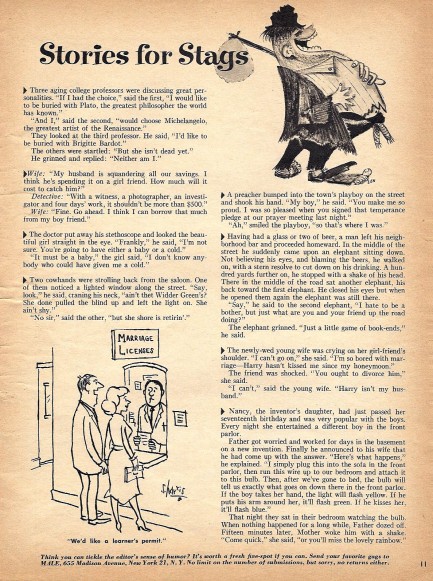 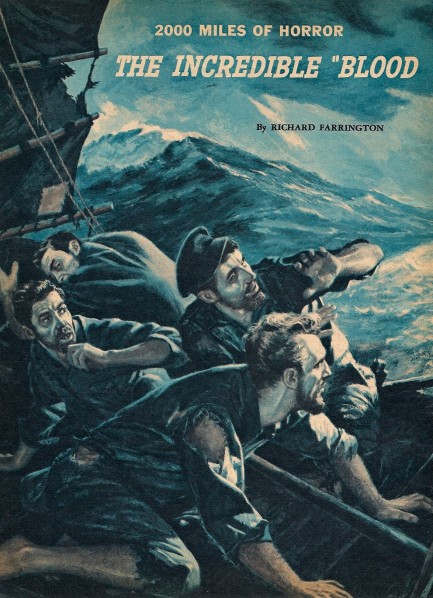 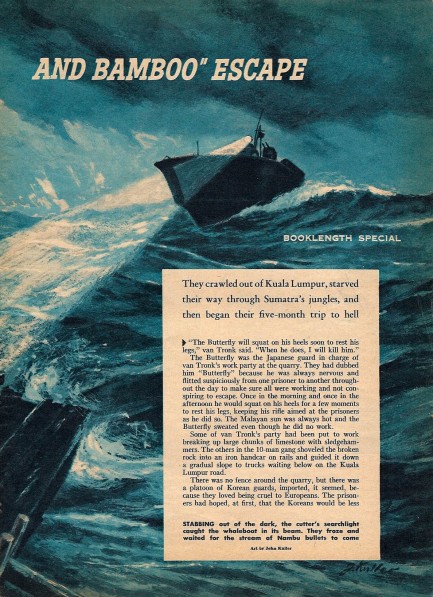 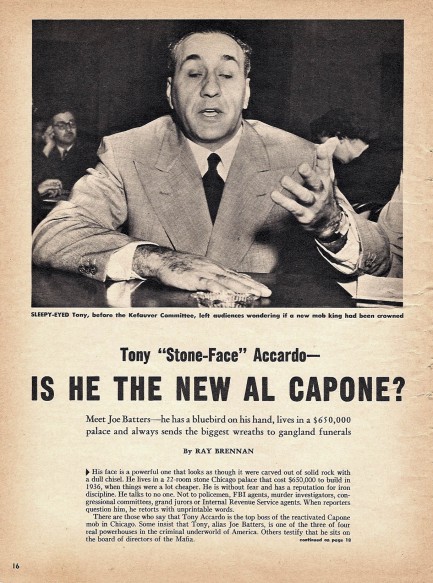 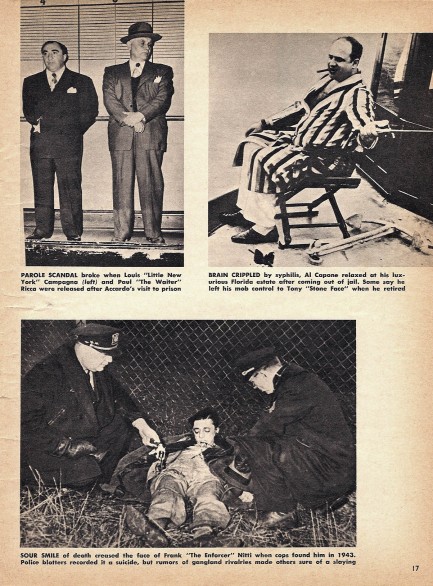  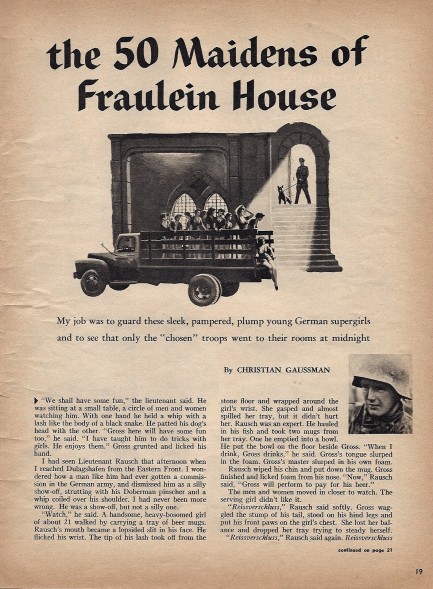 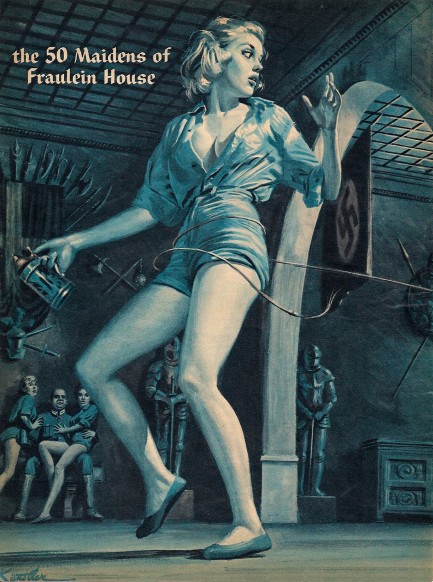  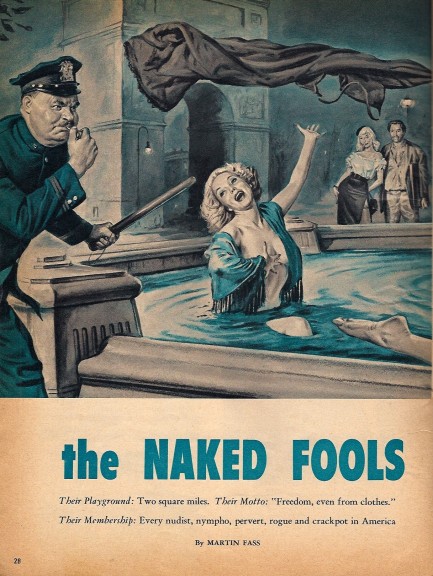 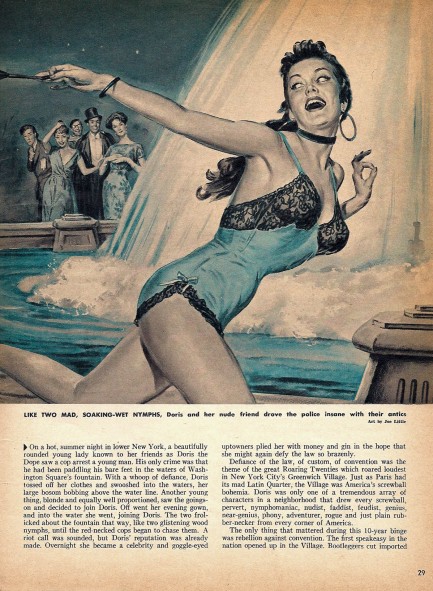 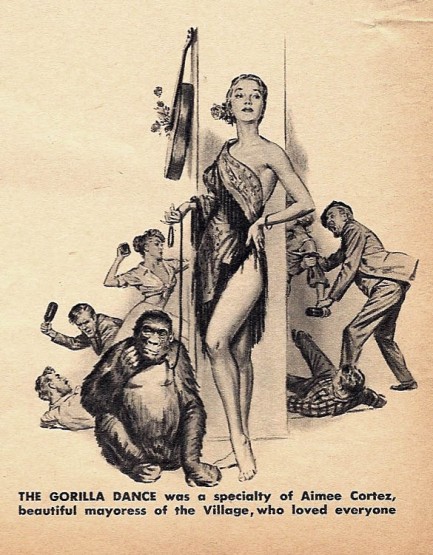 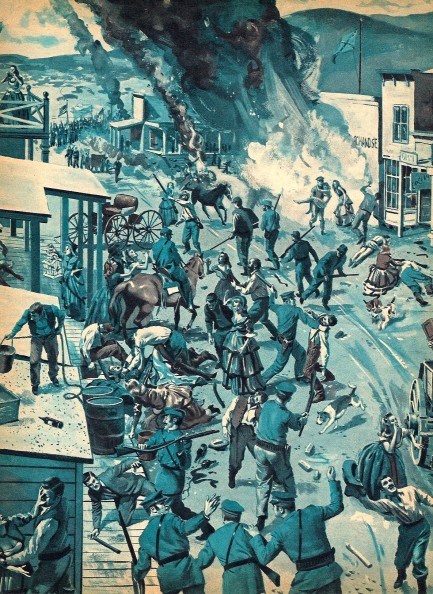 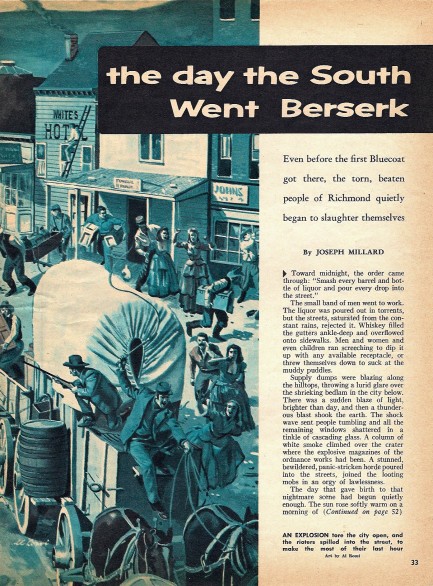 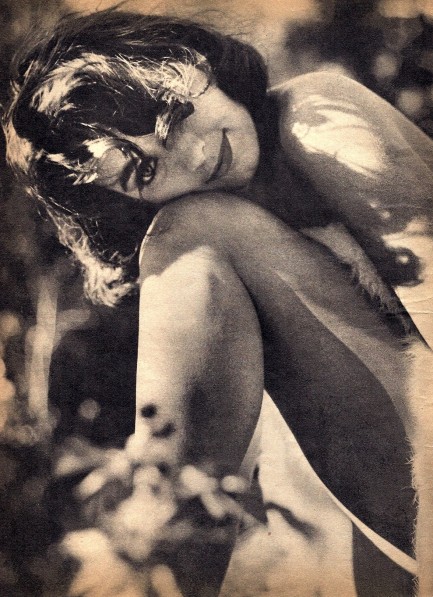 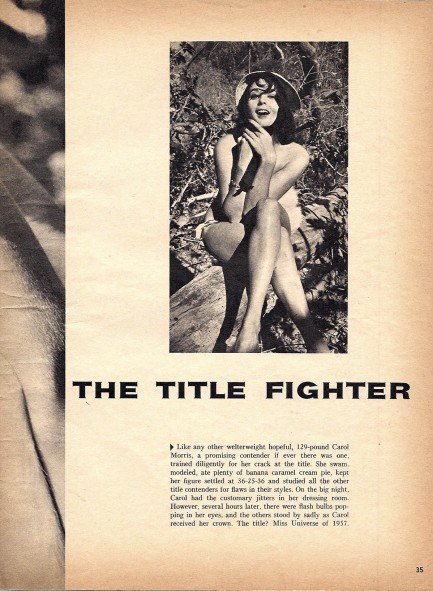 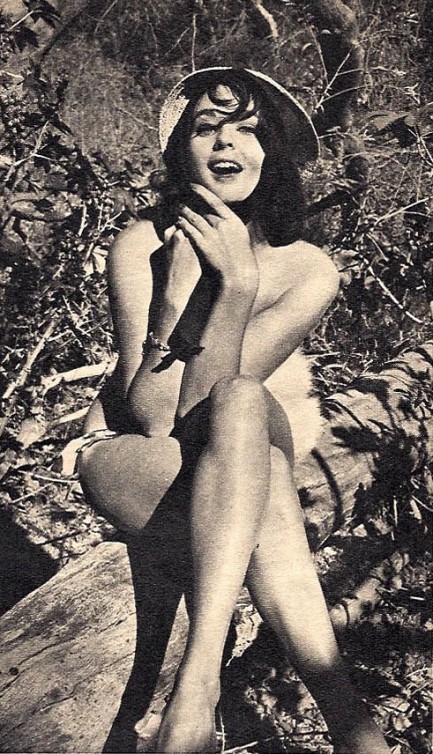 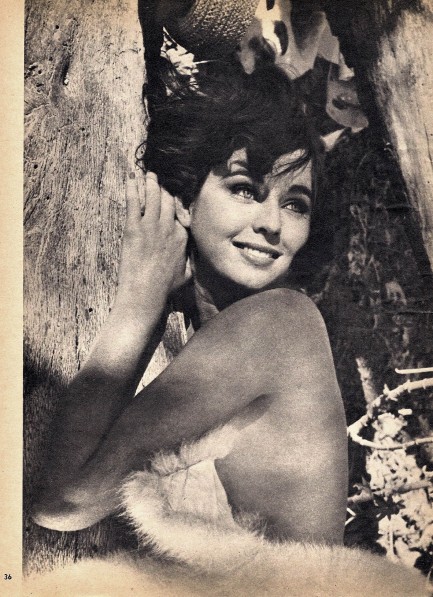 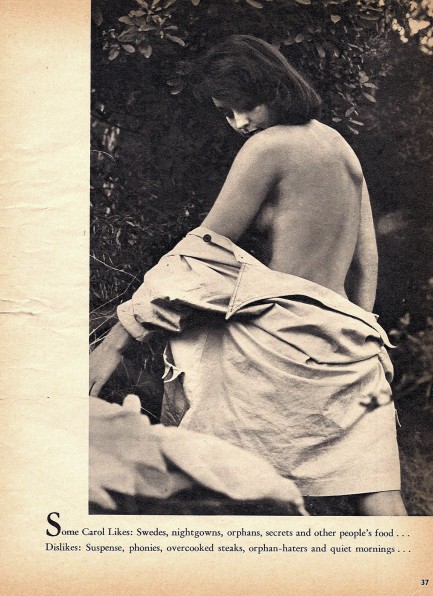 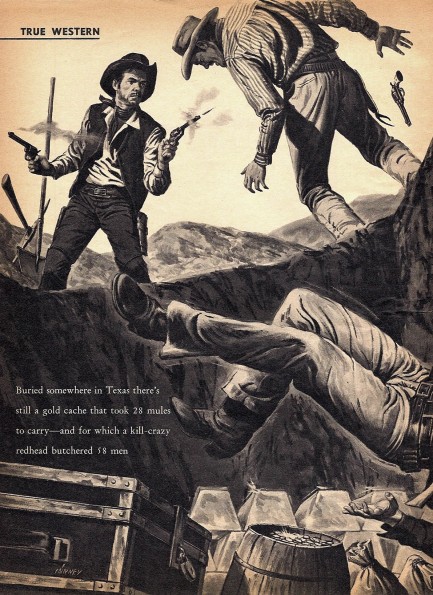 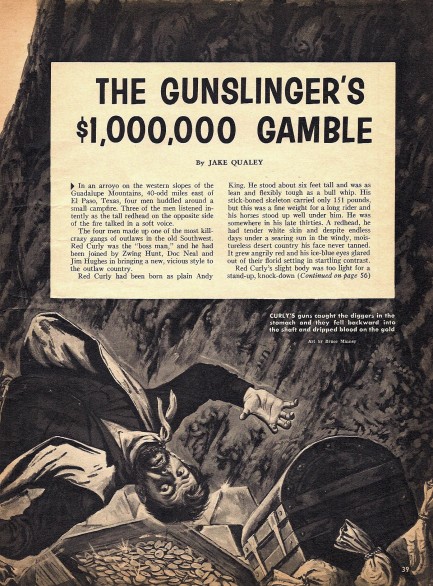 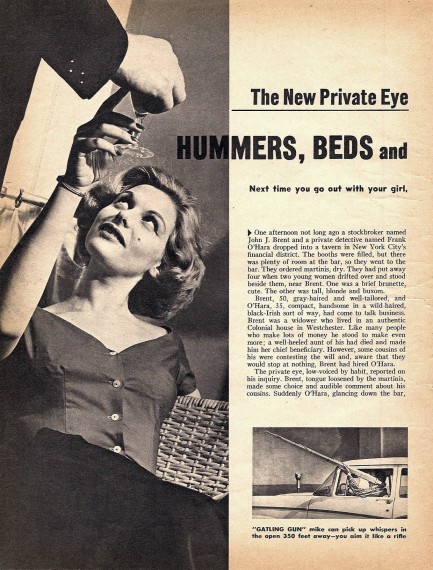 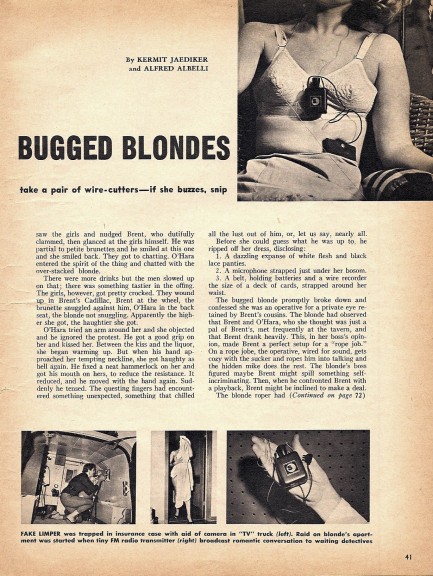 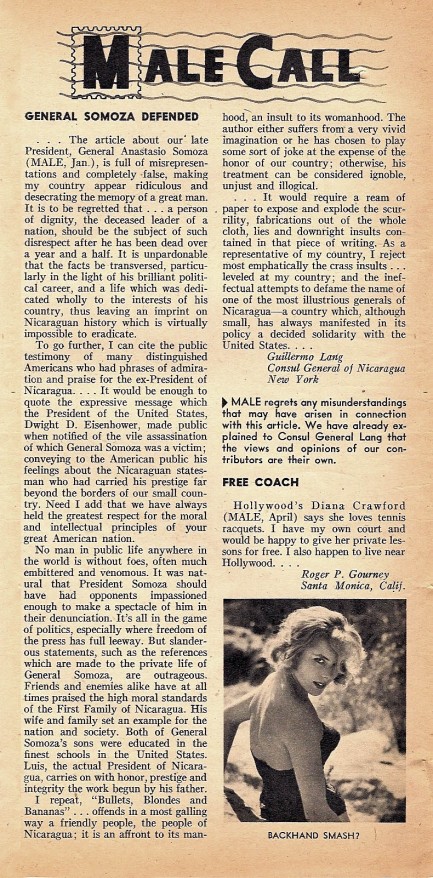
 Delivering thrills all year round. 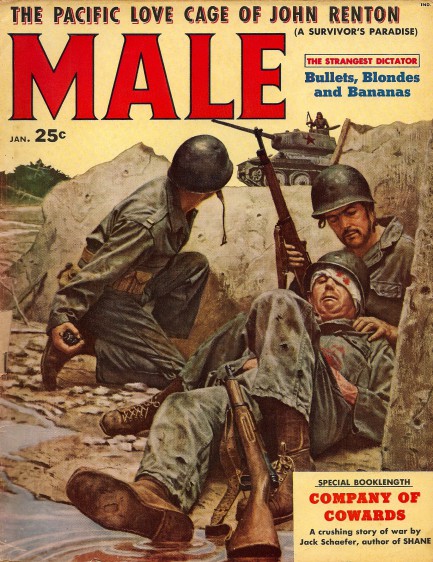
Stan Borack painted the cover of this issue of Male from January 1958, and the interior art comes from Samson Pollen, Bob Schultz, John Leone, James Bama, Bob Stanley, John Kuller, and Tom Ryan. Not a slouch in the bunch. The magazine contains a preview of Shane author Jack Schaefer’s novel Company of Cowards, the Civil War tale of a group of Union officers who have all been busted down to the rank of private, but who are formed into a special unit and given a chance to earn back their honor. That chance takes them into Comanche country where they face an assortment of deadly challenges. Also in this issue you get famed model Diane Webber/Marguerite Empey—who we’ve been seeing a lot of recently—doing a nice photo feature and complaining that since being elected Queen of the Nudists by a national sunbathing association all anyone wants to talk about is her naked lifestyle. But we think that’s just the editors trying to come up with an angle for the text. Webber was an official advocate of nudist lifestyle and even promoted her special brand of spiritual nudism in television interviews, so we doubt she was fed up with it at this point. The photos were shot by Russ Meyer, and we’re pretty sure they’ve never been on the internet before, which is always a fun moment for us. Please enjoy. Twenty scans below. 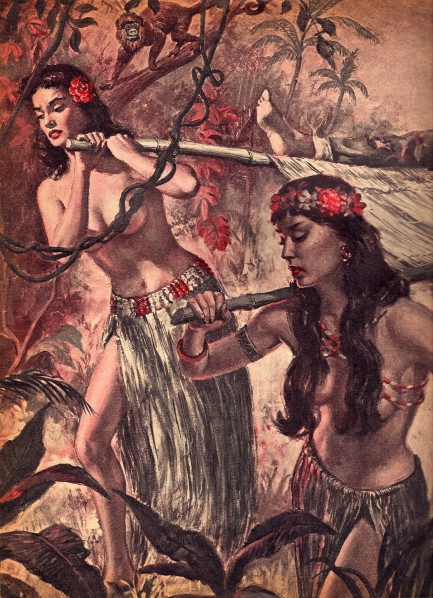 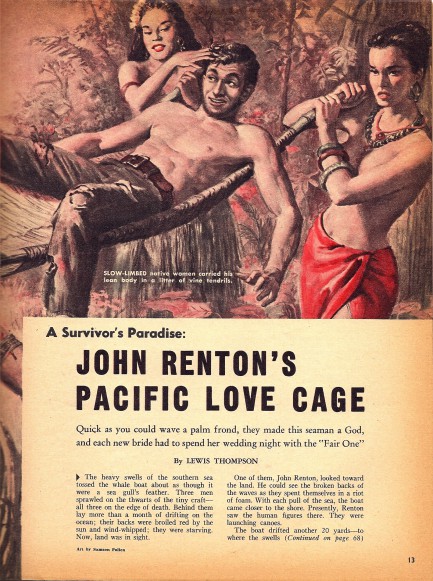 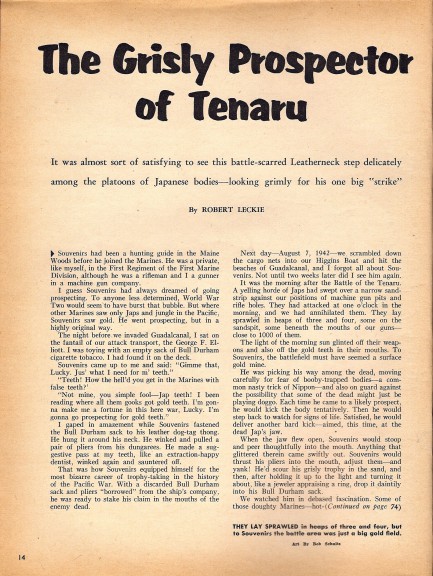 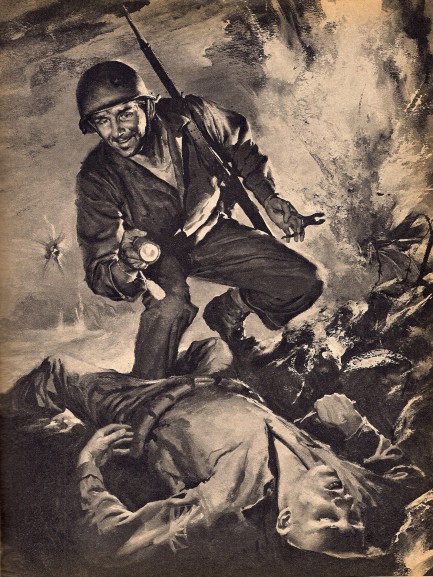 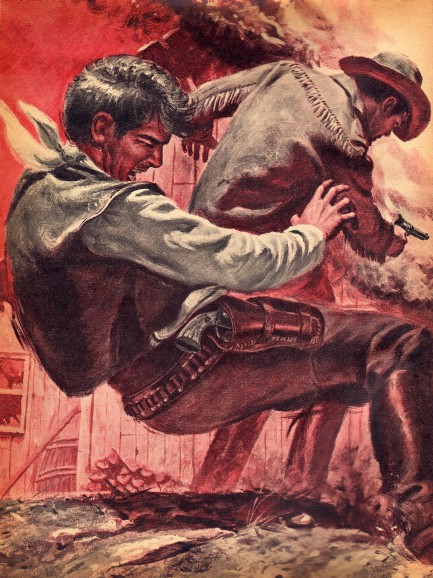 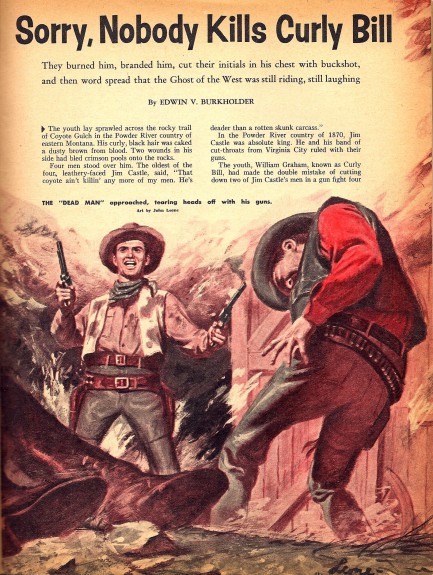 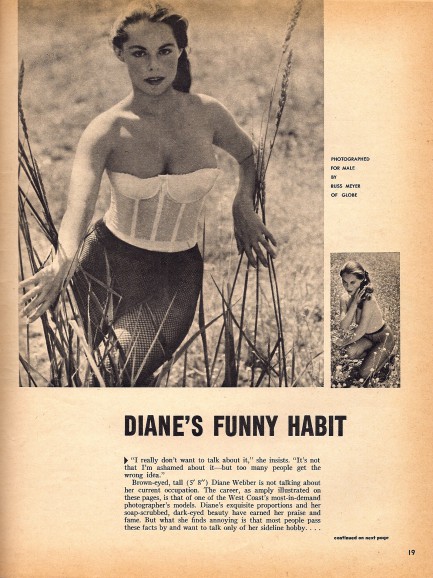 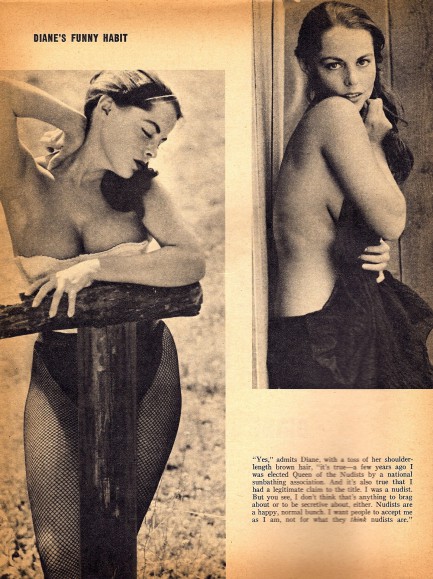 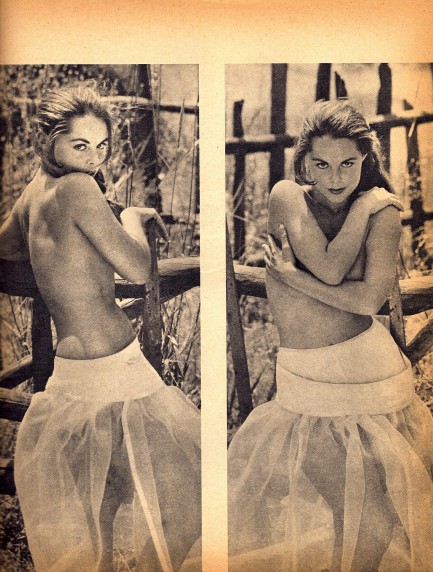 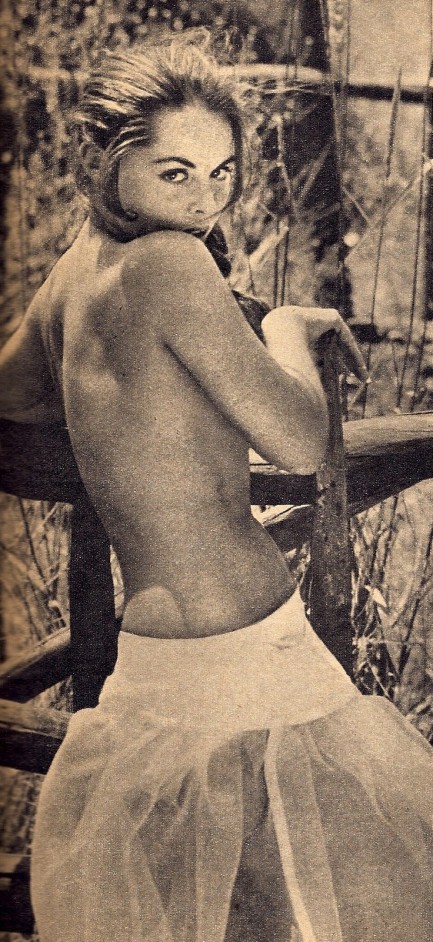 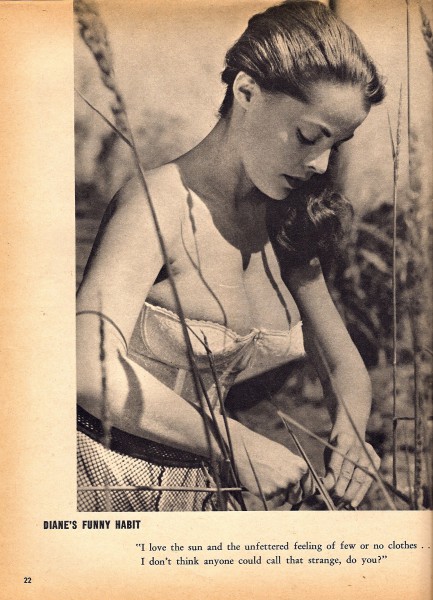 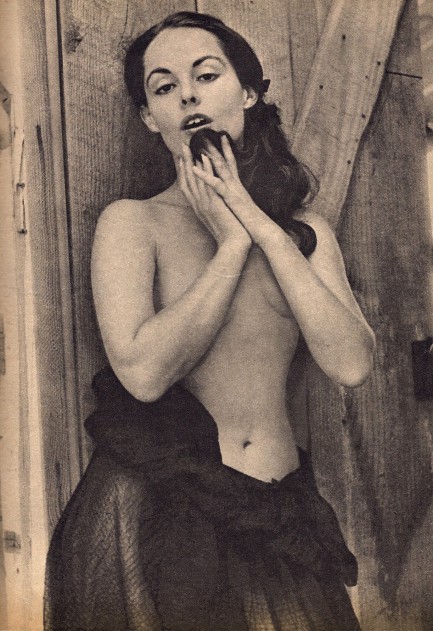 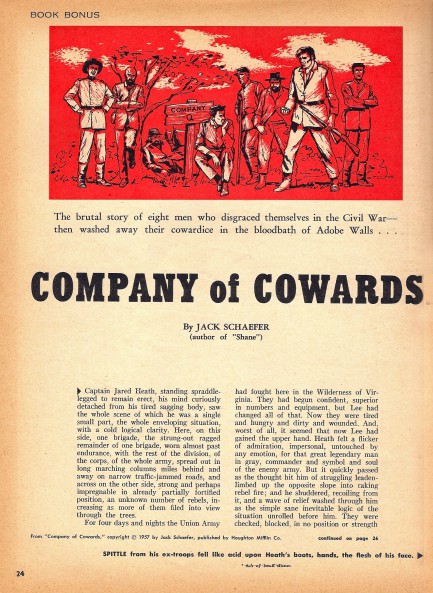 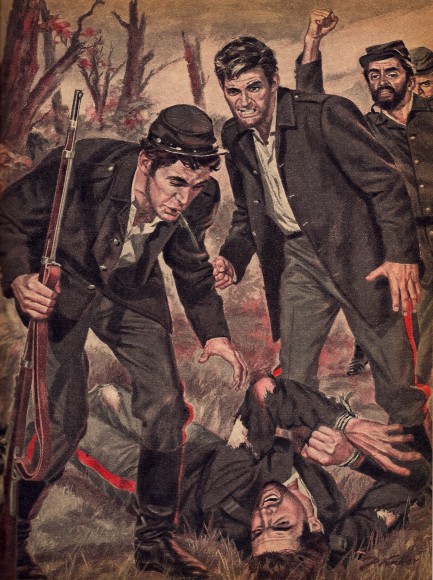 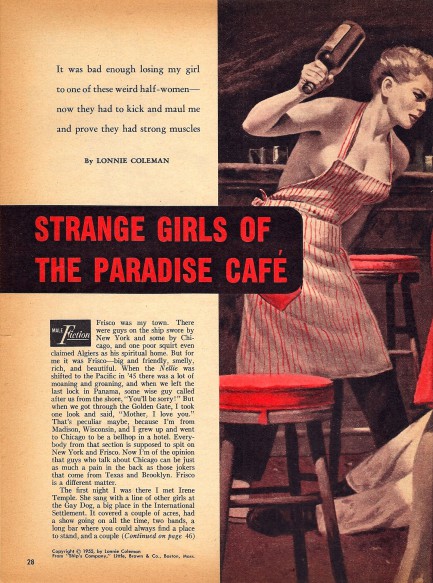 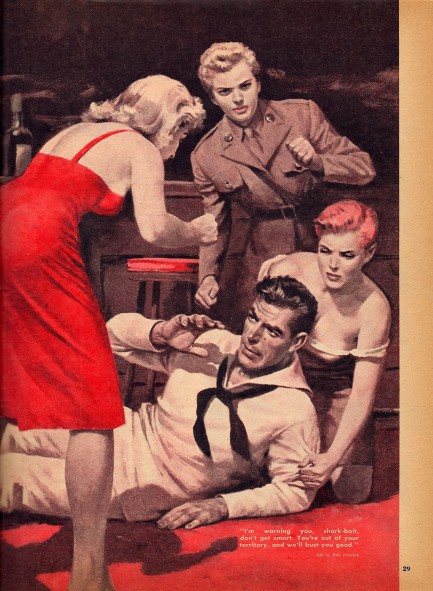 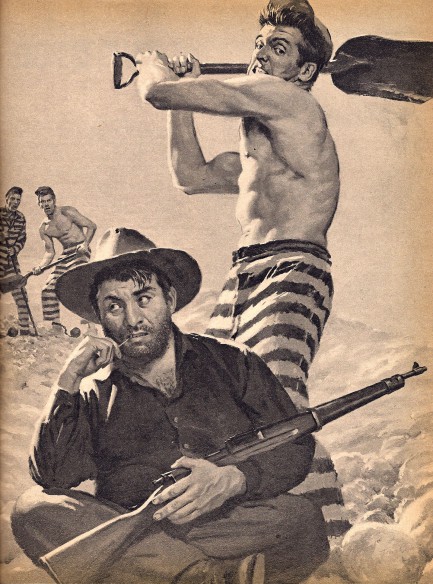 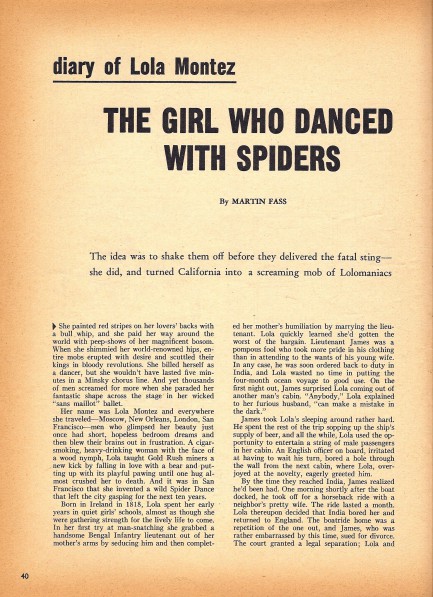 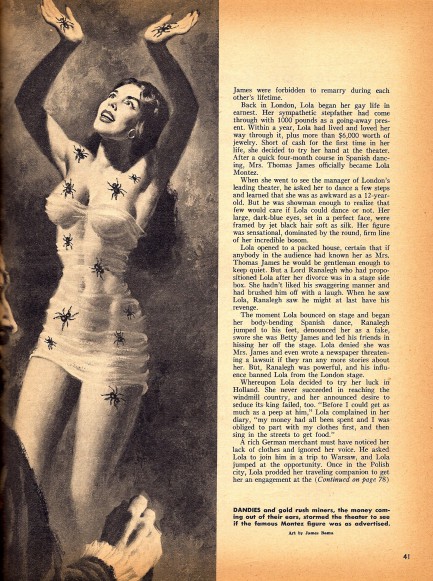 
 So, before I pull you up, remember in college I had a crush on that girl and you went and had sex with her? 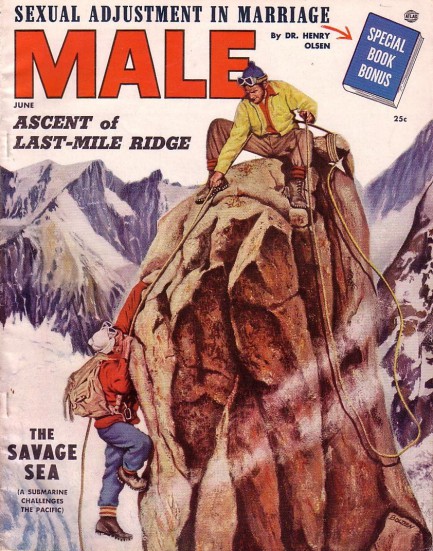
How does that Marvin Gaye/Tammi Terrell song go? We think it’s, “Ain’t no mountain high enough to keep me from getting even with you.” Or at least it should be. The above cover of Male is from June 1954 and it has art by Mel Bolden, who got his start working with Norman Rockwell and was probably the most prominent black illustrator of his era. We’ll put together a collection of his excellent stuff a bit later.
 The Male capacity for violence. 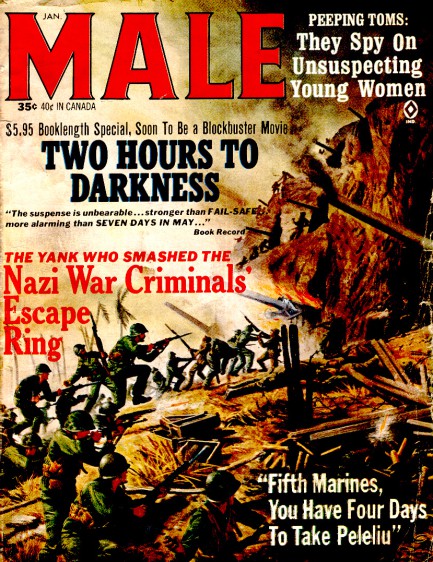
Above is a Mort Kunstler cover for Male painted for the January 1965 issue. Kunstler was famed for his war panoramas, as we’ve discussed before, and if you click his keywords below you’ll see several more martial covers from him that we’ve shared. Inside Male you also get art from Charles Copeland, Samson Pollen, and Gil Cohen. The model feature is Susan Radford, who is described as a starlet but who we’d never heard of. Turns out it wasn’t just us. We checked the usual databases and found no mention of Radford anywhere, so it seems Male editors were premature in dubbing her a major riser. Male focused on all kinds of violent adventures, but especially those dealing with warfare. This issue has four war stories dealing with the Soviet Union, China, and the Nazis, but the most notable entry is South African author Anthony Trew’s gripping Two Hours to Darkness, published here as booklength fiction. The tale is described in the contents as “the nightmarish spine-tingler that will be the movie blockbuster of 1965,” but it looks like Male was wide of the mark again, because no film based on the book was ever released. So Trew had to settle for selling a measly 3.5 million copies of the novel in sixteen languages, the hack. We have a dozen scans below.
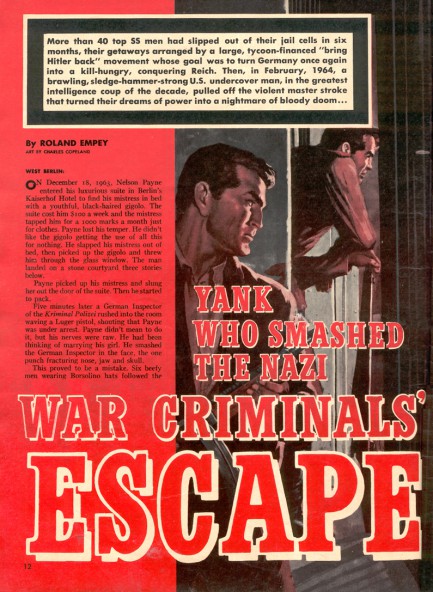 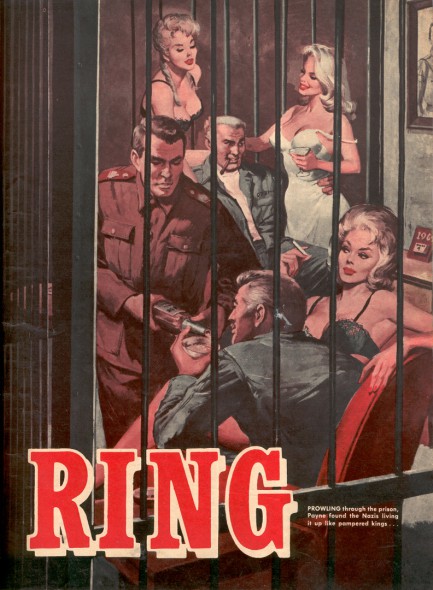 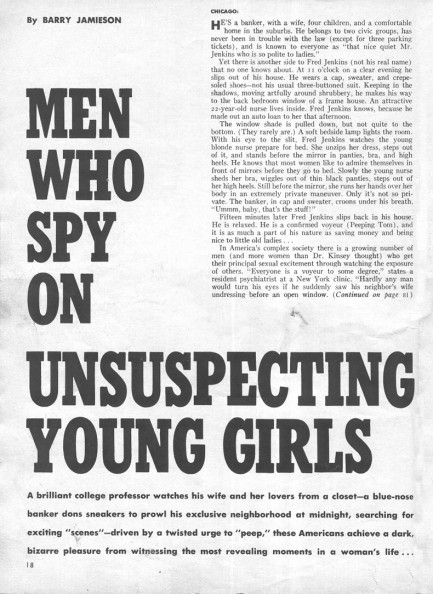 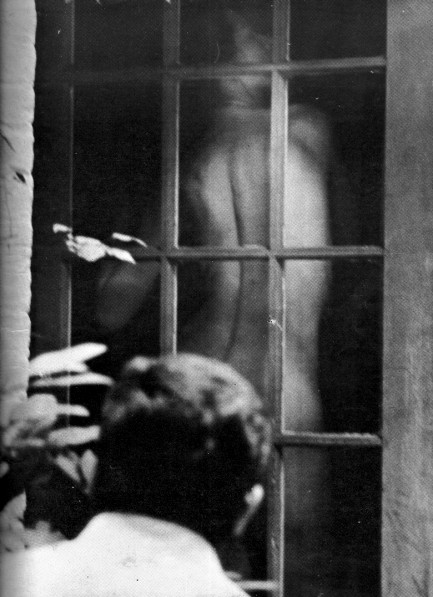 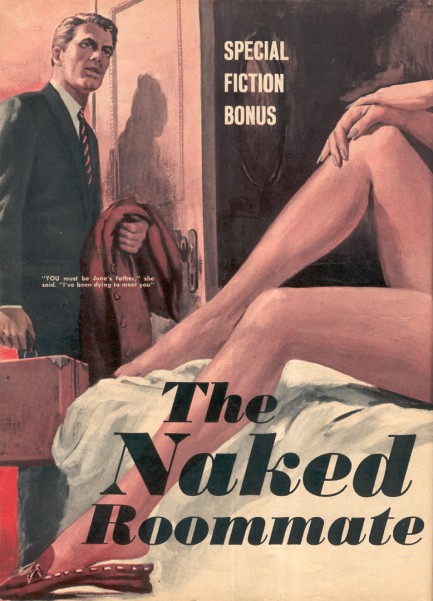 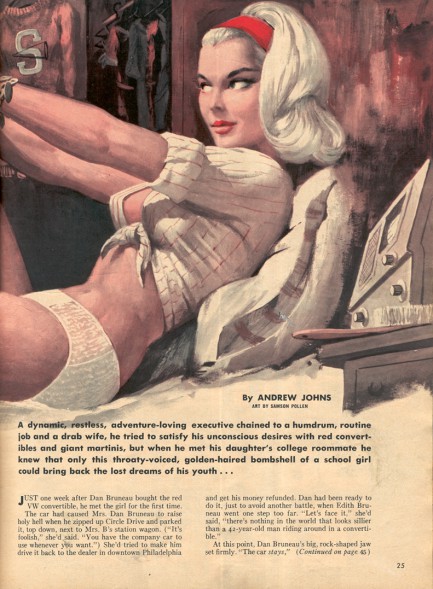 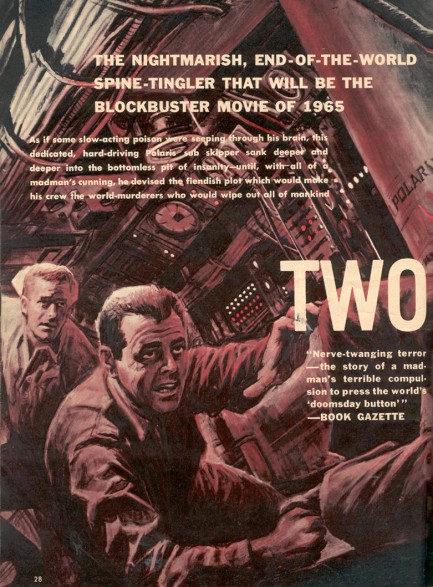 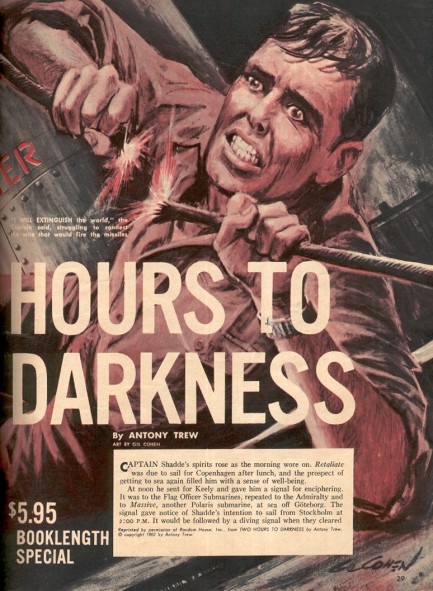 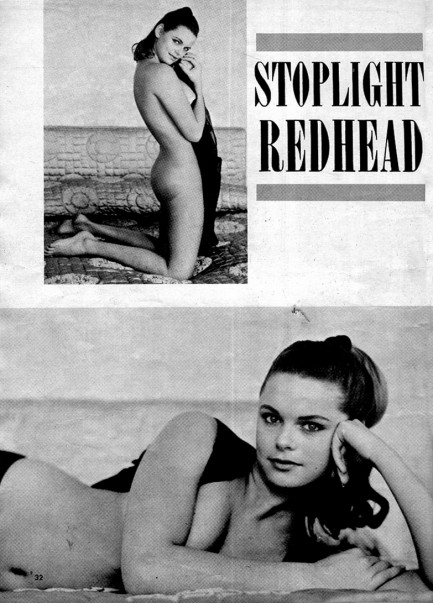 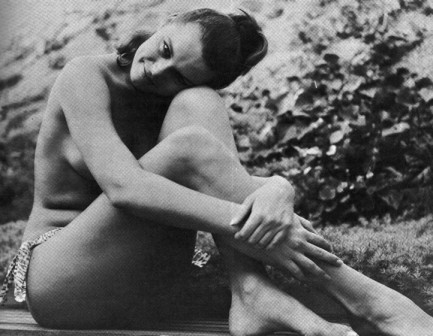
 But ask now the beasts, and they shall eat thee. 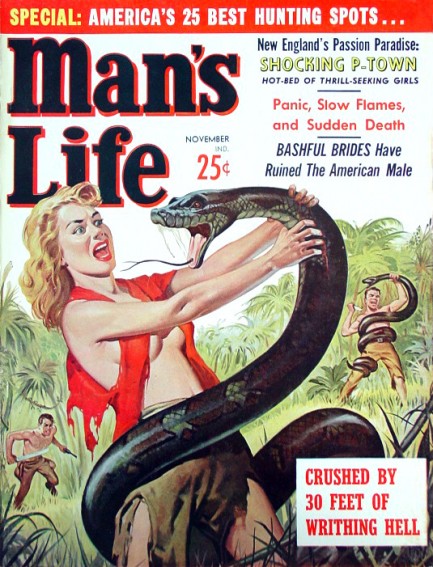
It’s been a while since our last collection of animal attack magazine covers, so on this lovely Friday (at least where we are) we thought we’d give nature a chance to express its opinion about humanity. And its opinion is: “I hate all of you. Even the pretty ones.” We have eleven more examples of nature's unreasonable stance below, including a great piranha cover that features the one guy who in real life would know better than to be attacked being attacked. Anyway, just to give you an idea how many men’s magazines there were, and how pervasive this animal attack theme was, all the publications we've posted are different. There are actually even more, but we couldn’t locate good scans of those. Which reminds us to thank the original uploaders on these.

|
 |

The headlines that mattered yesteryear.
2003—Hope Dies
Film legend Bob Hope dies of pneumonia two months after celebrating his 100th birthday. 1945—Churchill Given the Sack
In spite of admiring Winston Churchill as a great wartime leader, Britons elect
Clement Attlee the nation's new prime minister in a sweeping victory for the Labour Party over the Conservatives. 1952—Evita Peron Dies
Eva Duarte de Peron, aka Evita, wife of the president of the Argentine Republic, dies from cancer at age 33. Evita had brought the working classes into a position of political power never witnessed before, but was hated by the nation's powerful military class. She is lain to rest in Milan, Italy in a secret grave under a nun's name, but is eventually returned to Argentina for reburial beside her husband in 1974. 1943—Mussolini Calls It Quits
Italian dictator Benito Mussolini steps down as head of the armed forces and the government. It soon becomes clear that Il Duce did not relinquish power voluntarily, but was forced to resign after former Fascist colleagues turned against him. He is later installed by Germany as leader of the Italian Social Republic in the north of the country, but is killed by partisans in 1945.
|

|
|

It's easy. We have an uploader that makes it a snap. Use it to submit your art, text, header, and subhead. Your post can be funny, serious, or anything in between, as long as it's vintage pulp. You'll get a byline and experience the fleeting pride of free authorship. We'll edit your post for typos, but the rest is up to you. Click here to give us your best shot.

|
|



